| |||||||
| Search Forums |
| Advanced Search |
| Go to Page... |
 |
| Search this Thread |  55,466 views |
| | #61 |
| BHPian Join Date: Nov 2009 Location: Bangalore
Posts: 135
Thanked: 426 Times
| Re: To the Lost City of Incas - Peru on a Budget! There are travelogues, there are good travelogues, and there are even epic travelogues. And then there are those written by people like deky. You, sir, can give the Lonely Planets, the Sawdays, the Rick Steves and others a run for their money! Peru is on my bucket-list too - may just end up being a wishlist...Thank you for taking us there. Rated 5 stars only because there is nothing higher! |
| |  ()
Thanks ()
Thanks
 |
| |
| | #62 |
| Senior - BHPian Join Date: Apr 2010 Location: Zurich
Posts: 2,962
Thanked: 3,534 Times
| Re: To the Lost City of Incas - Peru on a Budget! deky, congrats on winning the contest and making the trip you always wanted to! I dont think I ever wanted to visit Peru, but with all your pictures of food it is a different story. But I am sure you will save me some money by taking us through Peru through this thread. Can you please also put up a link to the concise version of the story that you entered in this contest? It would be fun to go through the trip again. To be honest I am more curious how you could make a concise version, as every step of the journey was so entertaining in the first place. I am sure you will write a good one here too, we await further instalments. One more thing, you went to Paris and I hope you did and saw what you intended to. Its a place close to my heart, I would have flooded you with information if I knew you were going there  |
| |  ()
Thanks ()
Thanks
 |
| | #63 | ||
| Senior - BHPian Join Date: Jul 2008 Location: Jaipur
Posts: 1,194
Thanked: 1,247 Times
| Re: To the Lost City of Incas - Peru on a Budget! Quote:
Quote:
Paris was fun, more than anything else we enjoyed the food there!! Travelogue Contd!! 29/05/2013 (Contd..) – Half Day Trip to Sillustani After finishing with Uros islands, we had no plans for the rest of day. Initially we had decided to just rest post lunch and linger around in Puno itself. But Puno did not seem to be a place that had any other attraction other than Lake Titicaca. So while on our way back to the hotel from Puno Harbour, we saw a lot of shops offering organized tour to a place called Sillustani. Basically, Sillustani is pre Incan burial ground that is located about 35 kms from Puno. I had read about this earlier when researching about Peru and had decided to give it a miss as from Puno onwards all the places we would be visiting would only be about history of Peru and nothing else. But since we had nothing to do in Puno and also the fact that the tour prices being offered were less than half of what they were on the net we decided to go. The tour included pick up and drop from our hotel. Service of an English speaking guide and the entry ticket to Sillustani. The tour would be conducted in a Tempo Traveller type of a bus. ABOUT SILLUSTANI Sillustani as mentioned earlier is a Pre-Inca Burial ground for the nobility of the Colla tribe. It is situated on a plateau about 35 kms from Puno and is partly surrounded by Lake Umayo. Before the Inca’s took control of the Lake Titicaca area, the Colla Tribe was a major force to reckon with in the area. They used to bury their nobility in funerary towers called chullpas. These cylindrical shaped chullpas housed the remains of complete family groups along with their belongings and plenty of food. The towers only had a small opening in the east, just large enough for a person to crawl through, which would be sealed immediately after burial. However nothing remains inside the towers, thanks to grave robbers and plundering armies. Yet, some of the chullpas are well preserved. Infact the architecture of the Pre Incan chullpas is considered to be more complicated than of those of the Inca’s because the conservationists are still finding them hard to rebuild them. The outside walls of the towers are made of massive blocks of stones kept one top of the other. A ramp was used to transport the stones on to higher platforms. THE TOUR The tour bus picked up from our hotel exactly at 1415 hrs. We were the last ones to get in so we got the last and the most uncomfortable seats to sit on. Apart from us, the driver and the guide, there were about 15 other tourists on the bus. It took about 20 mnts to get out of the crowded Puno town and hit the highway. For some time we traveled along the shores of Lake Titicaca and the guide kept on telling us about the History of the Lake, its inhabitants, the influence of various tribes on the area and so on. I was more interested in looking out of the window and enjoying the views of the altiplano (high altitude plateau). The vast area of plains at a height of above 3800+ msl were offering a great sight. Soon we diverted off the highway and were on our way to Sillustani. In about another 20 mnts we reached our destination. As mentioned earlier, Sillustani is on a plateau, hence visitors have to walk for about 20-30 mnts up hill to reach the burial site. But once up the plateau one can see lots of restored, unrestored and partly restored chullpas scattered all over. Our guide took us to some of the main ones and explained us the significance and the history. One more thing that adds to the beauty of Sillustani is that it is surrounded by a Lake called Umayo. The chullpas and the azure blue high altitude lake is magical. The tour of Sillustani got over in about 2 hrs and it was time to return. The sun sets really fast in Peru and by 1800 hrs it was night. Once back in Puno, we decided to get off the tour bus at the Main Square and walk back to the hotel. The idea was to kill time till 2000hrs, have our dinner and then return to the hotel as it tomorrow it was to be a really earning morning start. Tomorrow we would be taking a full day tour bus at 0700hrs from Puno to Cusco, the capital city of The Inca’s and travel further on From Cusco to Ollantaytambo for the night. Finally tomorrow we reach The Sacred Valley!! PICS SO FAR Starting the tour from Puno. A view of Puno City and Lake Titicaca in the back ground 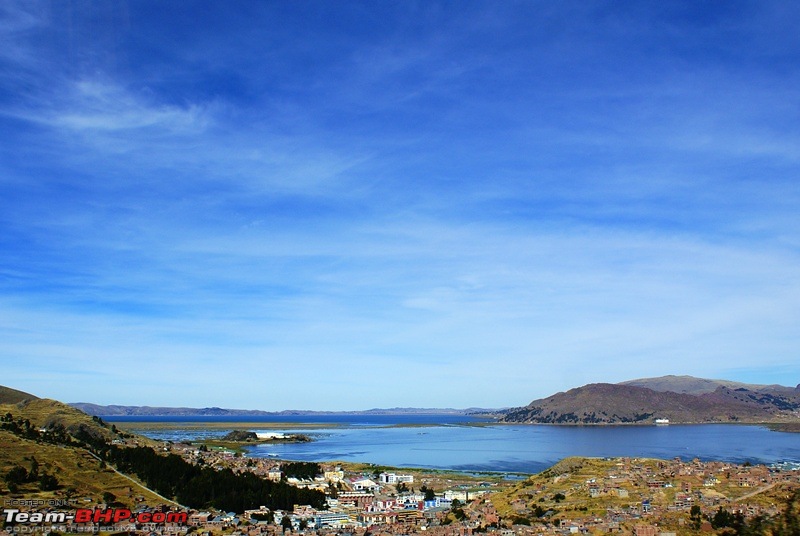 Farming on the Altiplano, Lake Titicaca and the Snow capped Peaks in the back ground. The snow capped peaks are in the Bolivian side 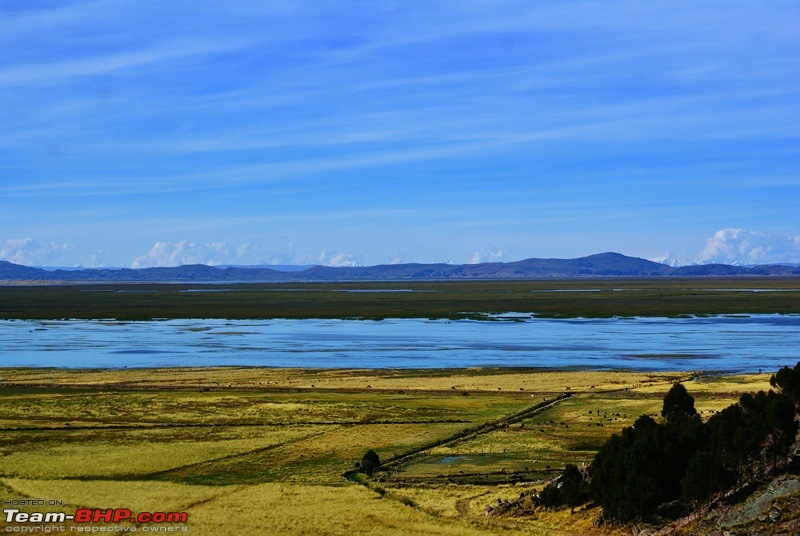 View of the altiplano and the rail link from Puno to Cusco bisecting the fields 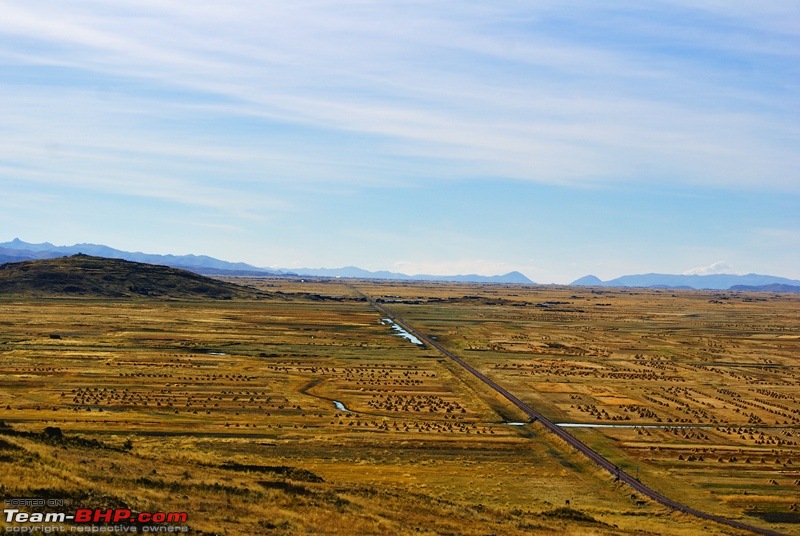 Sillustani and the chullpas by Lake Umayo on a plateau 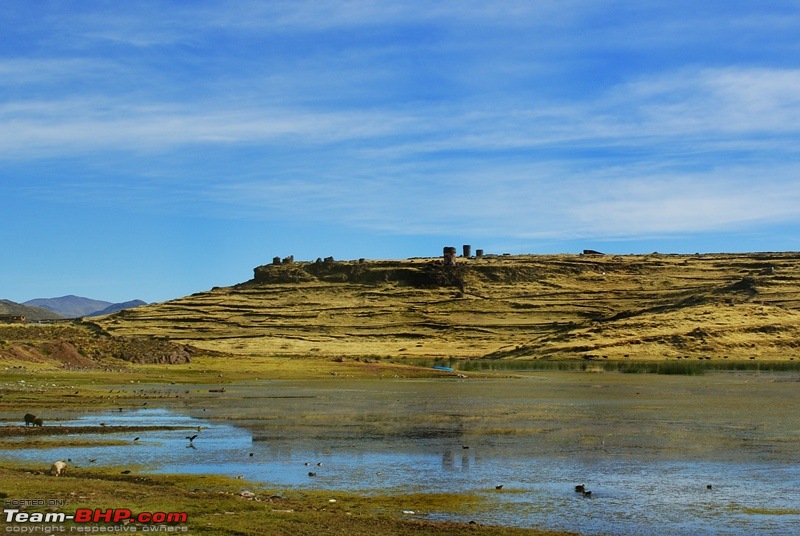 The climb to the chullpas starts  Chullpas scattered on the plateau  A small opening on the eastern side of the tower used for burying 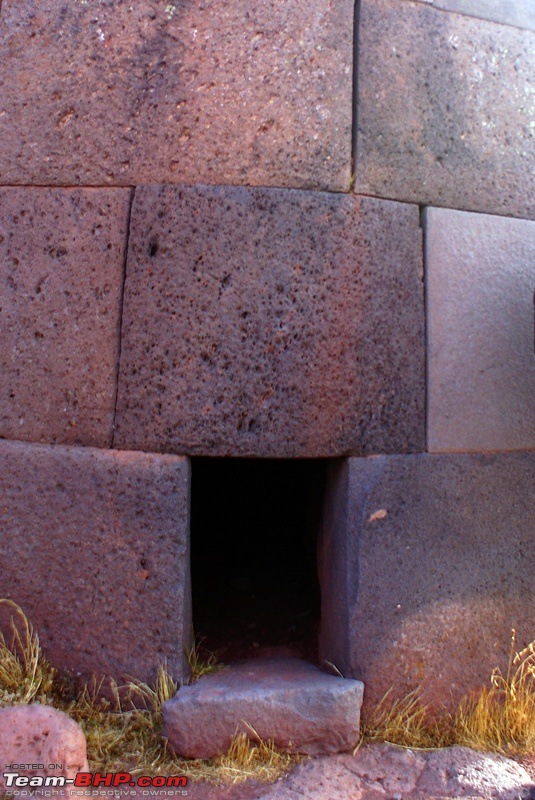 Unfinished chullpas or maybe chullpa's destroyed by grave robbers and armies for wealth    This was the highest chullpa at about 12 mtrs  A ramp construction to carry stones to make chullpa’s 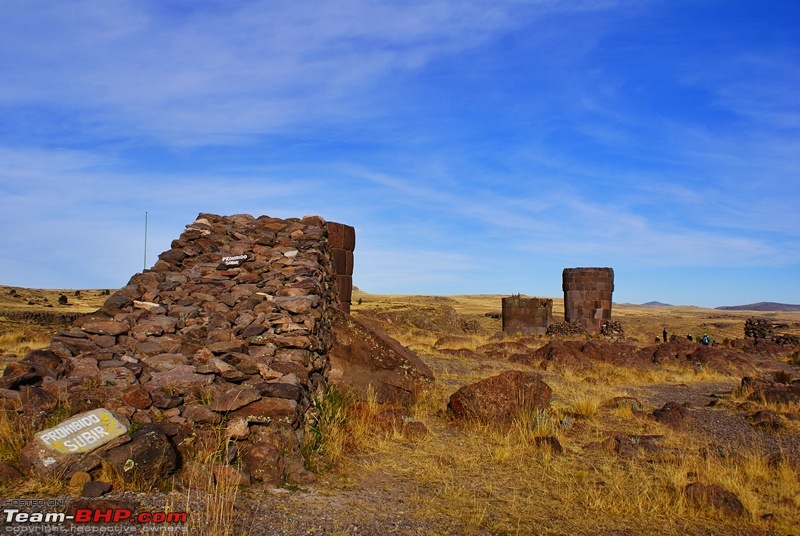 Lake Umayo as seen from the plateau 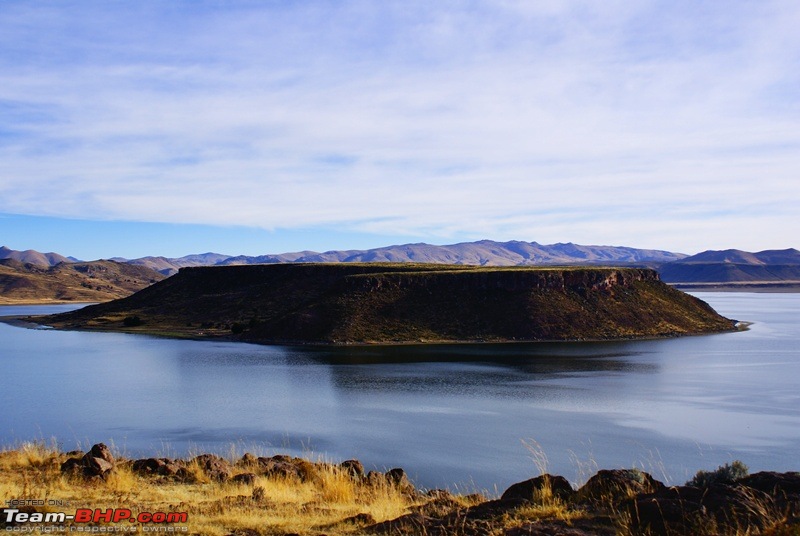 Returning back to the bus from Sillustani 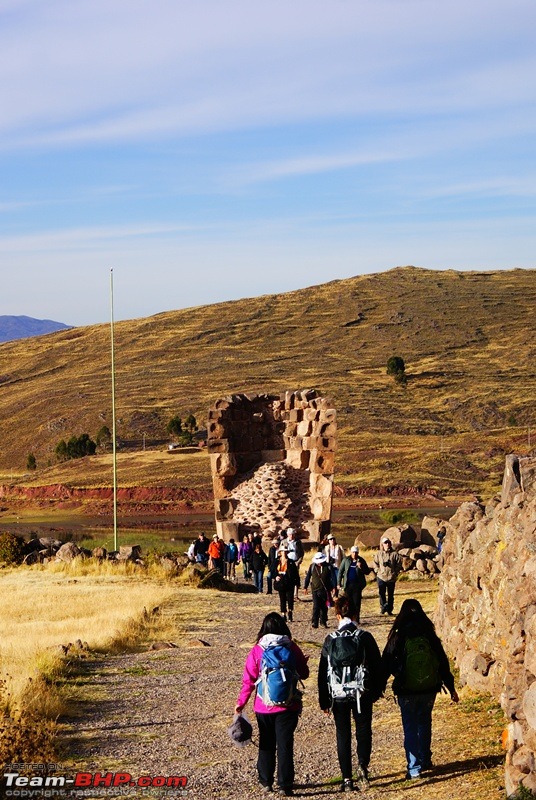 It was late in the evening and time to head back 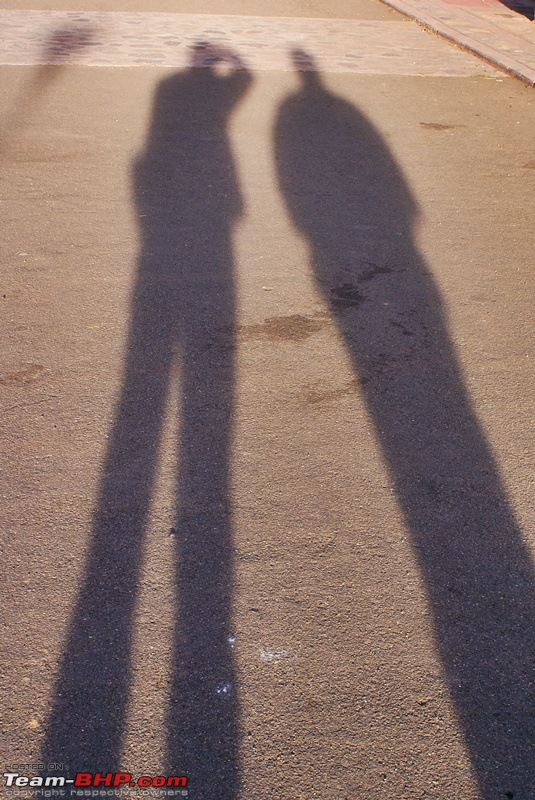 Sun set over Lake Titicaca 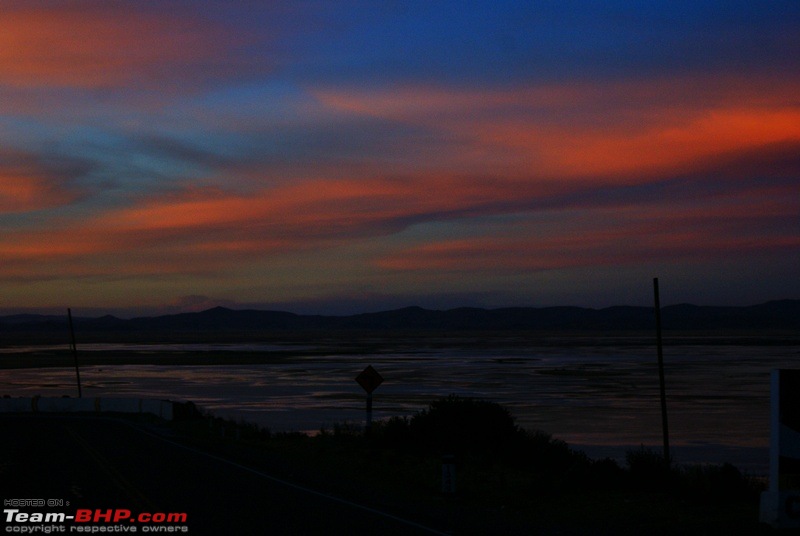 NEXT – OLLANTAYTAMBO & THE SACRED VALLEY | ||
| |  (5)
Thanks (5)
Thanks
 |
| The following 5 BHPians Thank deky for this useful post: | BlackBeard, dailydriver, jacs, laluks, yosbert |
| | #64 |
| Senior - BHPian Join Date: Jul 2008 Location: Jaipur
Posts: 1,194
Thanked: 1,247 Times
| Re: To the Lost City of Incas - Peru on a Budget! Sorry for the delay!!! 30/05/2013– Bus from Puno to Cusco and onwards to Ollantaytambo It was an early morning start from Puno. We were to catch a tour bus called ‘Inka Express’ to Cusco. The tour bus starts at 0700 hrs from the Bus Terminal at Puno, covers a distance of around 400 kms and reaches Cusco at about 1700 hrs. We were really looking forward for this day as today we would be reaching the most important city of the Inka Empire and that was Cusco. But we had plans to go ahead another 60 kms and stay at a place called Ollantaytambo. More about Cusco and Ollantaytambo later. We managed to get up by 0500 hrs and after having the complimentary breakfast we checked out of the hotel by 0615hrs. The taxi that we had pre booked the previous night was waiting for us. Luckily it was a bright and a sunny morning and no breeze so the temperatures were quite comfortable. It took us just about 10 minutes to reach the Bus terminal at Puno and by 0630hrs we were ready to check in at The Inka Express counter. INKA EXPRESS is a privately owned (infact I think all bus services are privately owned in Peru) tour company that runs service between Puno and Cusco and around. The ticket cost was USD55 (at the time we went) per passenger for the 400 kms journey. We had decided to take this guided tour as this route is considered to be the Old Inca trail originating from Boliva, across Lake Titicaca and onto Cusco, the Capital of the Inca Empire. Since it’s the old trail, there are some very important Archeological sites en route and the tour bus stops at them. I thought it will be a good way to see these sites. Apart from that the services provided on the tour are :- • Entrances to the different archaeological sites. • Buffet Lunch in Sicuani town. • Bilingual Staff. • Guided tours at all the archeological centers. • Mineral water, coca tea, coffee. • Tourist Assistance. • First-aid kit including emergency oxygen bottle. • Delivery bus tickets at your hotel. • Luggage storage. • Comfortable seats, satellite mobile phone communication, air conditioning, TV/ video etc. • Chemical toilet. NOTE:- Other ways to reach Cusco from Puno are- 1. Take a flight from the closest airport at Juliaca (46kms) 2. Take local buses, not as expensive and not as safe as Inka Express. 3. Take the Luxurious Andean Explorer Train from Puno to Cusco. Costs about 3 times more than Tour Buses. Inka Express bus  Once all the passengers checked in and the bus was full we made our way out of the terminal and headed out of Puno. The initial journey was around Lake Titicaca and on to the highway going towards Juliaca (the biggest town in Puno Region). Click on the link to see the route that we took. About 1.5 hrs into the journey we stopped at our first point of interest PUKARA Pukara in Quechua language means a fortress. This was one of the main regional centers in the Northern basin of Lake Titicaca. The small town of Pukara now has an impressive Church. Also excavation around Pukara has revealed loads of Incan and Pre Incan artifacts that have been displayed in a private museum. Pukara region 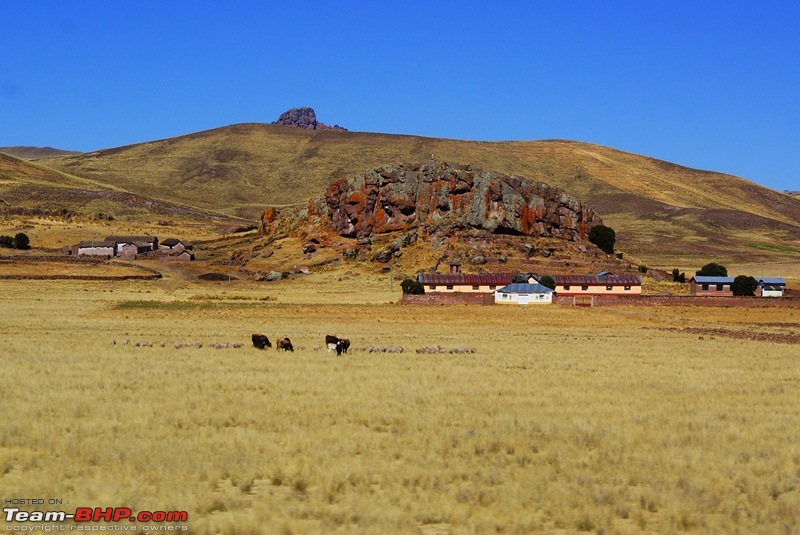 Church At Pukara – Was not Open 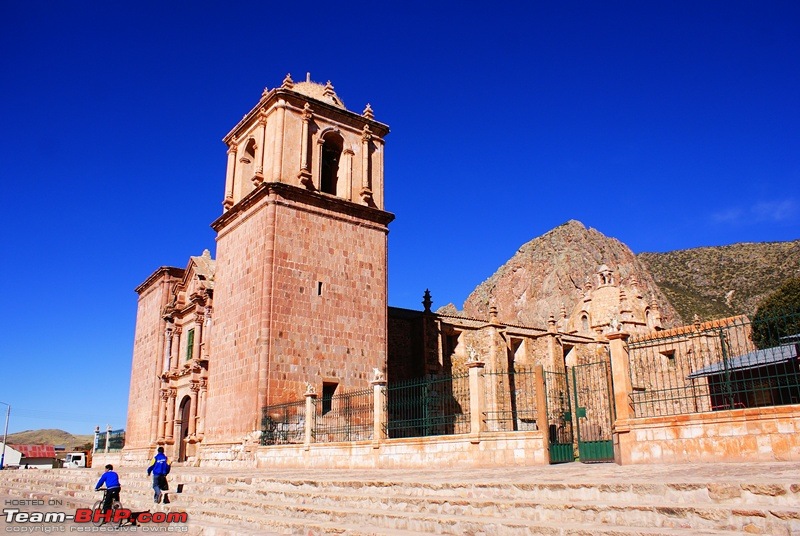 Houses have bulls displayed at entrance as its supposed to be sacred and ward off evil spirits  Arte facts displayed at a museum 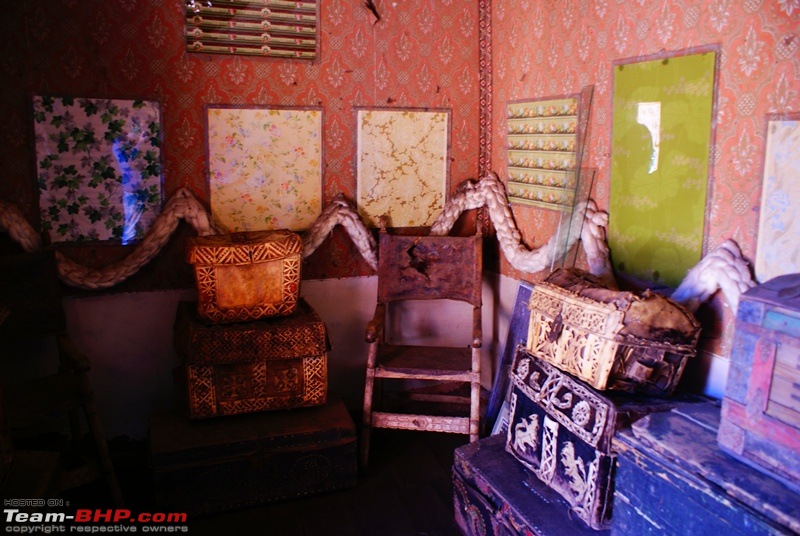 A real mummy excavated from Pukara  RAYA PASS After Pukara the bus continues on the plateau passing dry and barren mountains. Slowly after a little ascent the bus reaches La Raya or the Raya Pass. This pass at a height of 4338msl forms as the divide between the regions of Puno and Cusco. Also it is the watershed between the valley that drains into Lake Titicaca and the valley that leads down to Cusco and to the Sacred Valley. A small stream breaking the monotony of the region  Rail line from Puno to Cusco 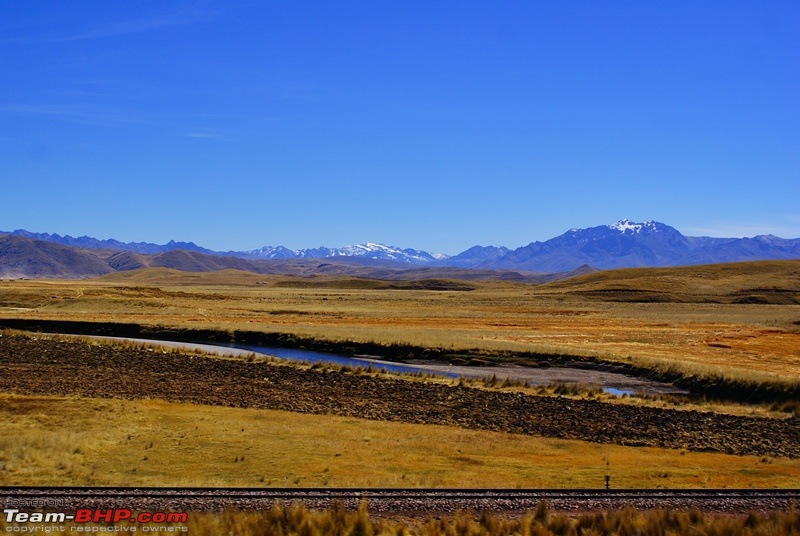  At Raya Pass 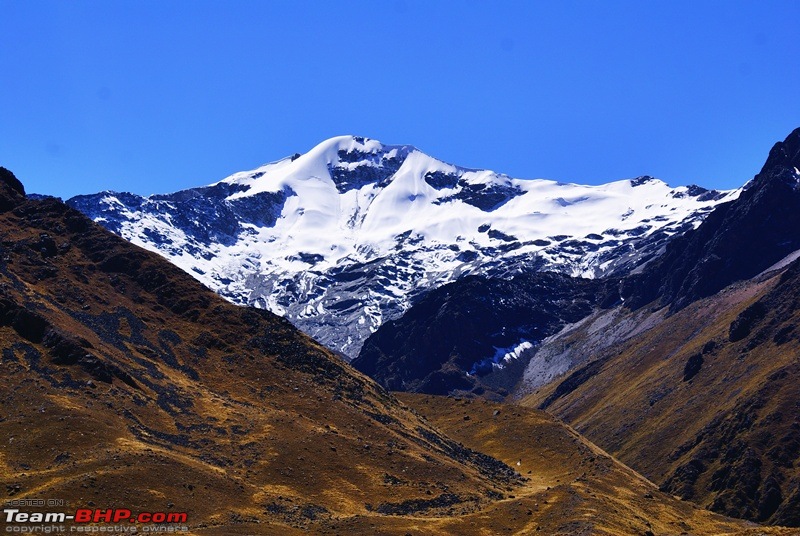 Souvenirs being sold at the pass  A mini volcano - hot water spring  Our guide explaining us about the surrounding  SICUANI Once the bus starts to descend you can see more greenery on this side of the pass than the other side. The plateau gradually ends and valleys appear. Barren mountains give way to greener slopes and more and more farmlands start to appear. The next stop is Sicuani where the tour breaks for lunch. It was an elaborate buffet lunch and was quite delicious. Greener and more cultivated side on the other side of the pass  Lunch stop 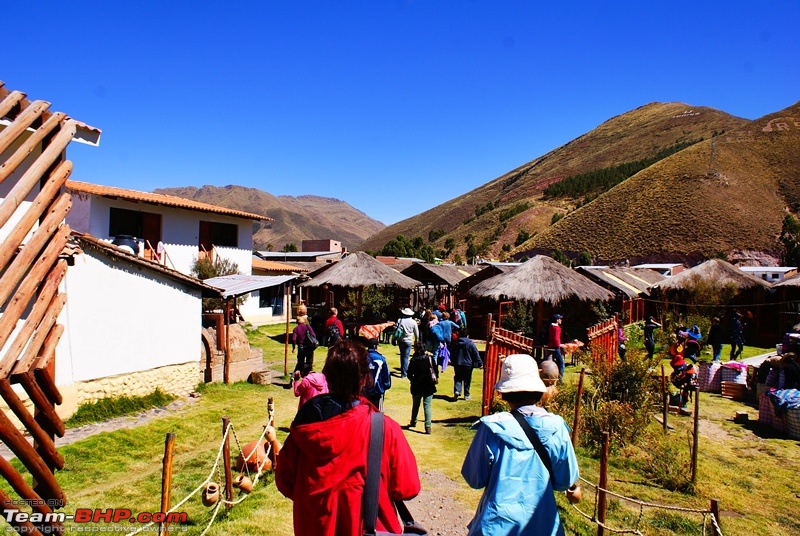 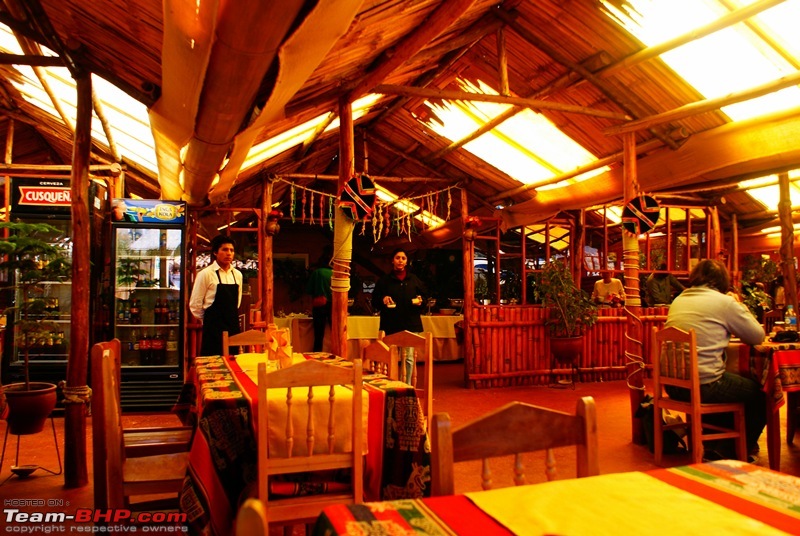 RAQCHI - TEMPLE OF WIRACOHA After lunch we stop at a place called Raqchi. Raqchi is an Inca archaeological site and is also known as the Temple of Wiracoha one of its constituents. It was one of the most important stops for the Inca’s while travelling towards Cusco. The complex of Raqchi consists of several different areas each designated with a specific function. Entrance to the Historical site of Raqchi  Temple Of Wiracocha The most prominent structure is the Temple of Wiracocha. Before being destroyed by the Spaniards, the Temple was an enormous rectangular roofed structure that measured 302 ft by 84 ft. It had a central wall and the wall was flanked by pillars to support the wall. Not much is left to be seen except the central wall and the base of the pillars. Both the wall and the pillars base was made out of stones displaying the high quality of Inca stone work. Before being destroyed the roof of the Temple was considered to be the largest size single roof in the Incan Empire. Remains of the Temple of Wiracocha 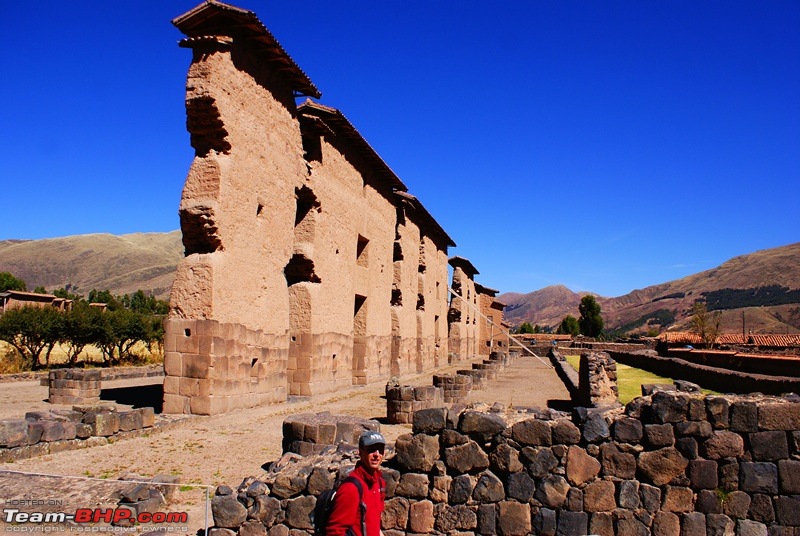 A pictorial depiction of the temple during Inca Period 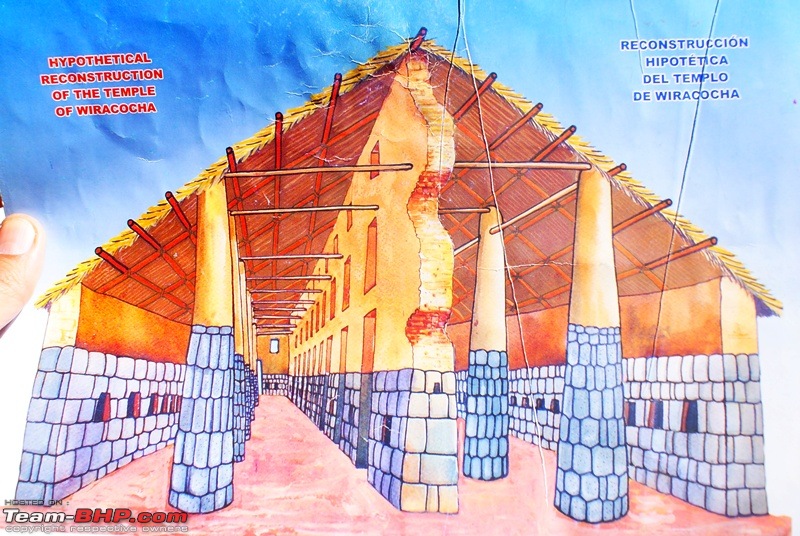 Living Quarters – Nobility and Priests Adjoining the temple to the north are 12 living quarters, which would have housed both priests and local administrators. The living area is divided into separate squared lots. All have niches in their walls which might have been used for storage, though some of the niches have cover posts, suggesting they may have held sacred objects. The living Quarters of the rich 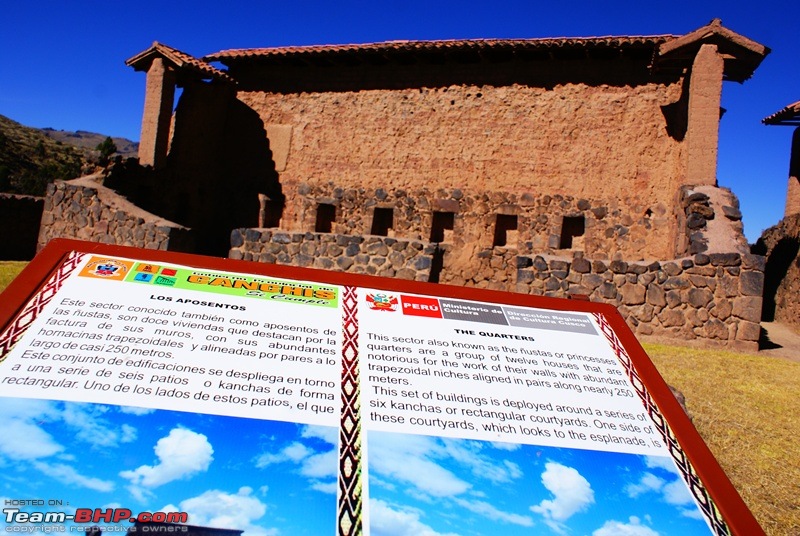 Square quarters with walls having niches to store items 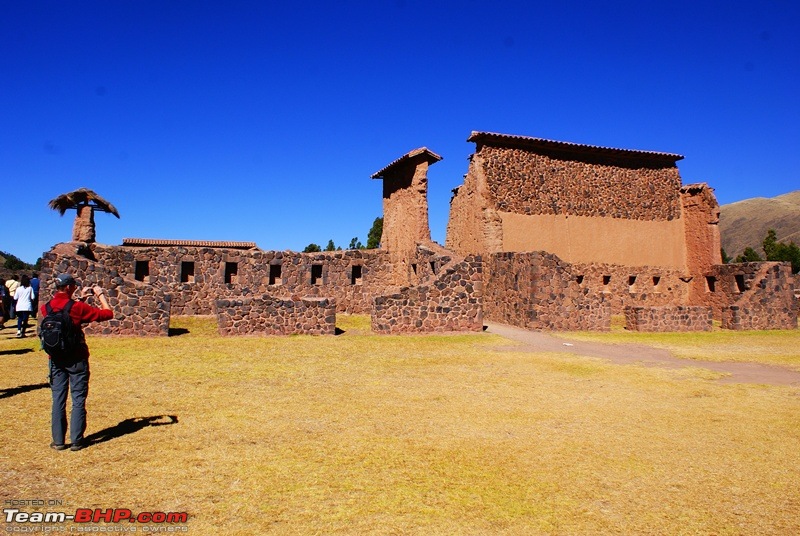 Main alleyway between the quarters  Living Quarters – Commoners Little ahead are the living quarters of the commoners. Its believed that the working class of the people used to stay here. Smaller in size these quarters are separated by a central alley. Pictorial depiction of the living quarters of the common people 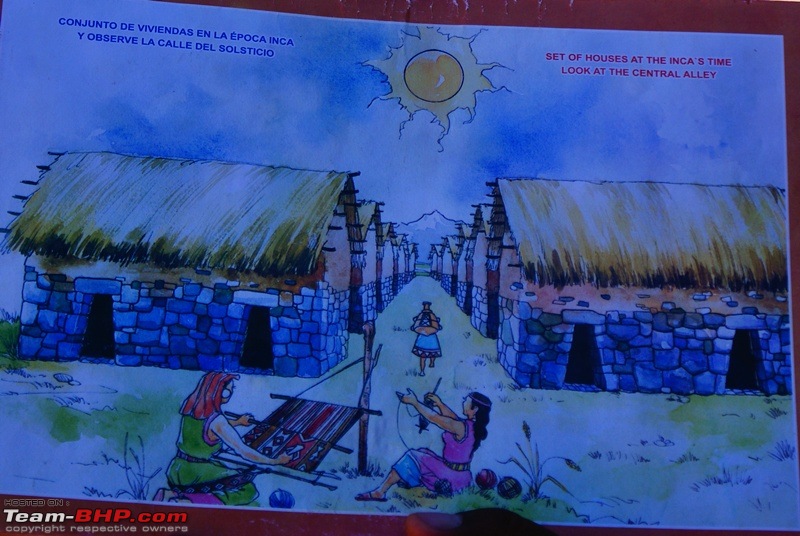 Remains of the living quarters 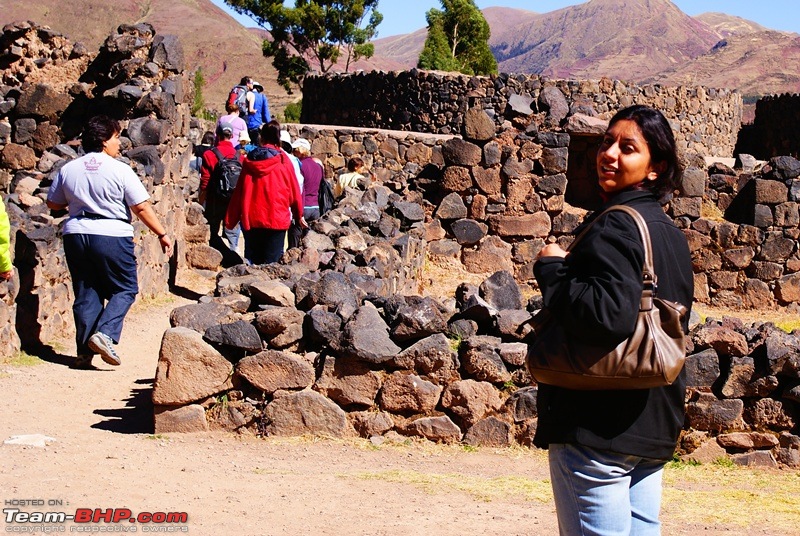 Storehouses Next to the living quarters for the commoners are round store houses made of stone and mud. These store houses used to store grains. These store houses are unique as they are round. No one knows the reason for them being round in shape. Remains of the round shaped storage houses  This is how a store house may have looked in those days  A panorama of the whole area of Raqchi  A common feature at all places of interest: Souvenirs and trinkets for sale  CONTD IN THE NEXT POST |
| |  (4)
Thanks (4)
Thanks
 |
| The following 4 BHPians Thank deky for this useful post: | aah78, BlackBeard, dailydriver, yosbert |
| | #65 |
| Senior - BHPian Join Date: Jul 2008 Location: Jaipur
Posts: 1,194
Thanked: 1,247 Times
| Re: To the Lost City of Incas - Peru on a Budget! CONTD. FROM THE PREVIOUS POST SAN JUAN BAUTISTA – HUARO As we move from Raqchi the next stop is an old colonial church at a place called Huaro. This church was built by Jesuits in the sixteenth century. It is strategically located on an Inca road system about 60 kms south of Cusco. In the 16th century, local artists were commissioned to create the murals and decorations. These images demonstrated a fusion of indigenous and colonial beliefs and styles. For years, new compositions were painted one on top of the other. Photography unfortunately is not allowed inside the church. Church at Huaro 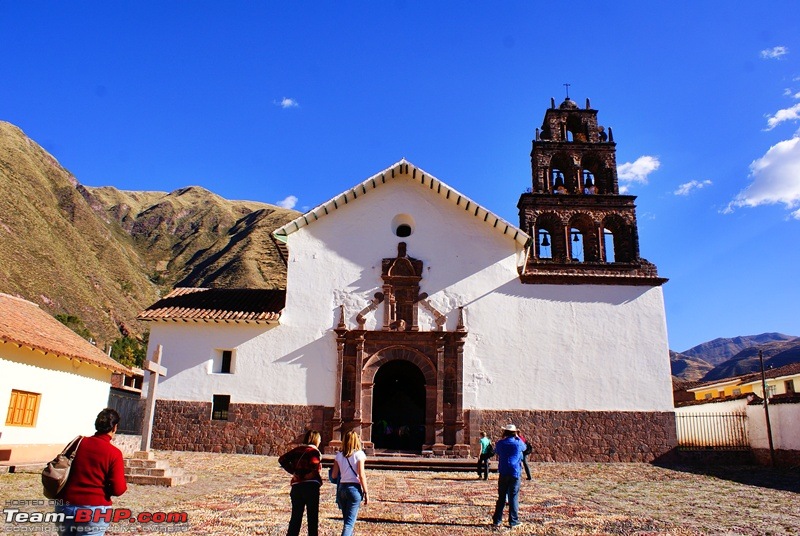 Beautifully painted walls 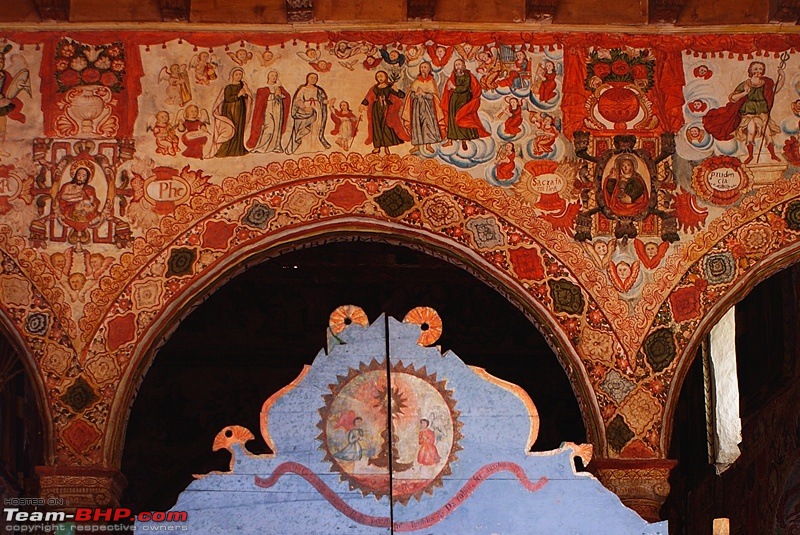 Huaro main square  Old colonial style balconies and doors 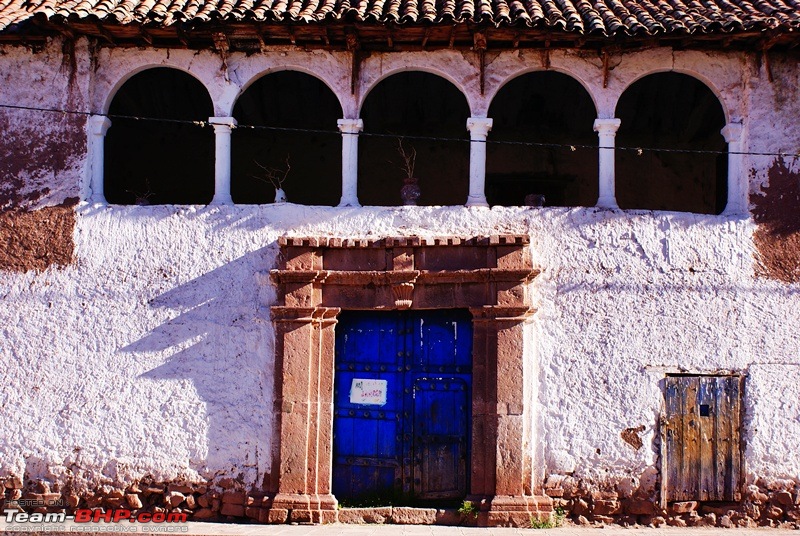 ANDAHUAYLILLAS – “SISTINE CHAPEL OF AMERICA” Soon we stop at another church in the village of Andahuaylillas. This is located 40 kms from Cusco and has one of the most impressive of the Colonial Churches. Built on a sacred platform or ‘Huaca’, the interior of the church boasts of intricate wooden carvings, gold and silver decorations, paintings and lots of murals. The altar itself is covered in gold leaf and is decorated with silver and mirror work all over. Since this part of Peru lies on a seismic fault, the church has suffered from major and minor earthquakes since it was built in the 16th century. The restoration of the church has always been an ongoing process. Again no photography is allowed inside the church Reaching the small town of Andahuaylillas 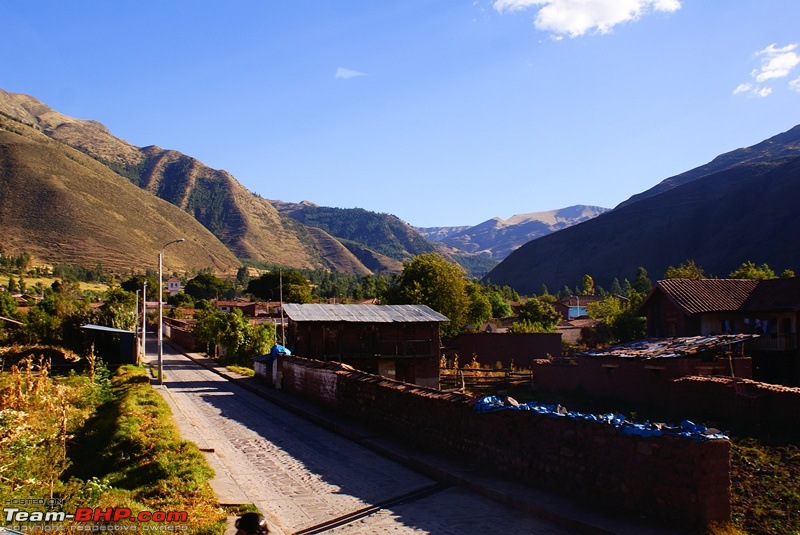 The beautiful church with its bell tower 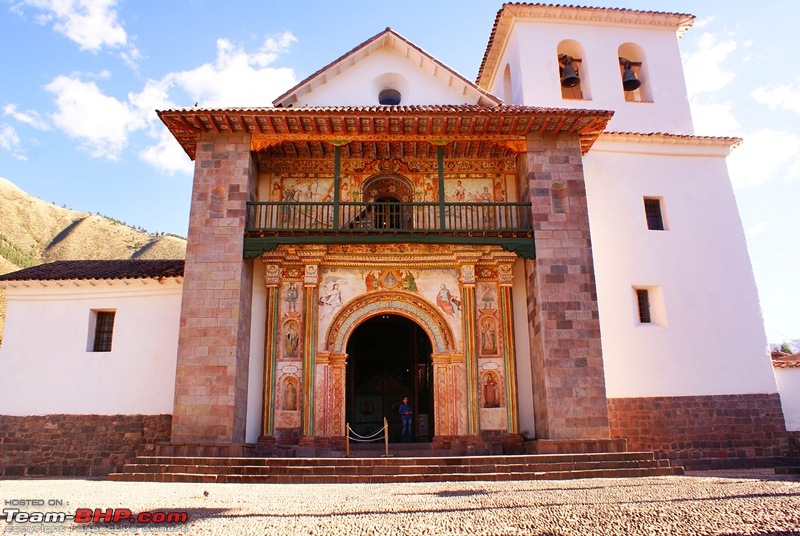 The well decorated and painted entrance  Once we got closer to Cusco the whole valley got a lot greener with Eucalyptus trees appearing on the mountains and a lot of farming happening at the valley basin. It’s interesting to note that all these trees seen around the Cusco region are of the same type and seeds were specially flown in from Australia for plantation. The tax collection gates just before Cusco on the Inca Trail. The travelers in olden days had to pay tax to the Inca government to enter the city of Cusco 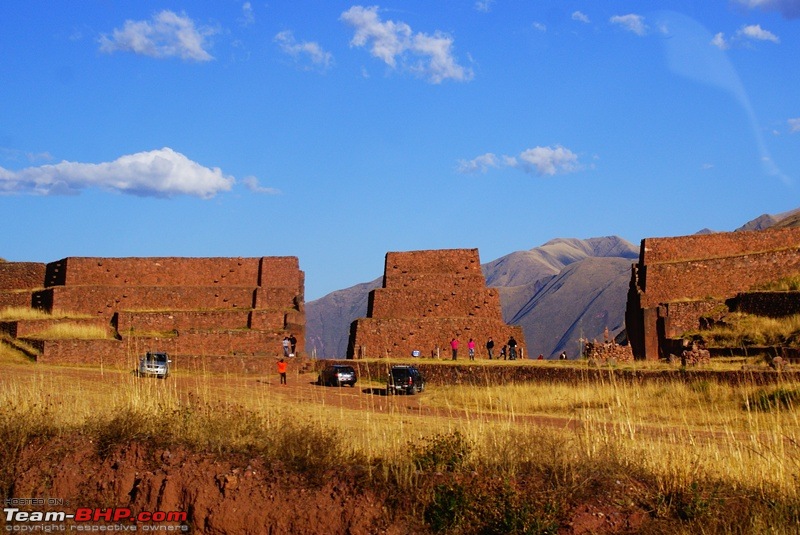 The green valley 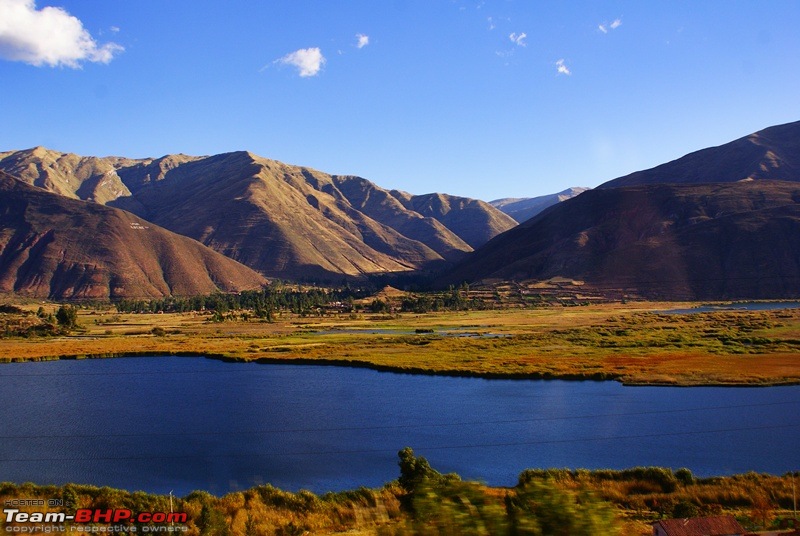 Eucalyptus plantation on the slopes 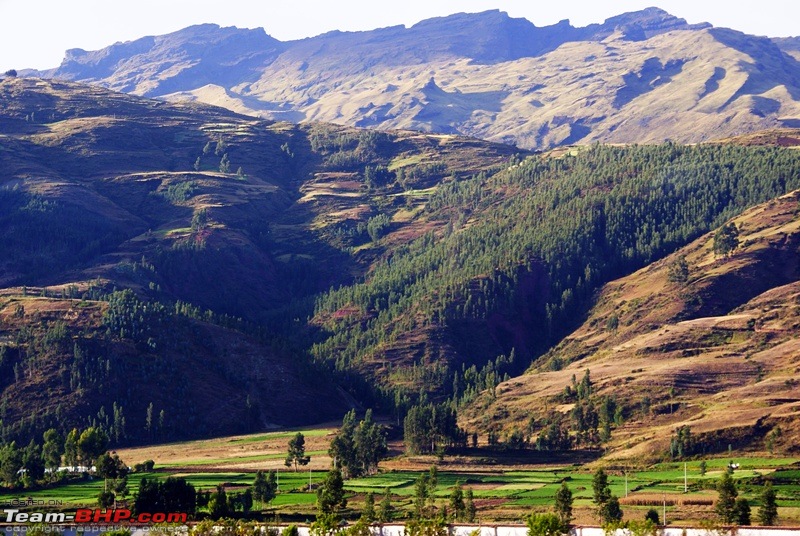 We reached Cusco at around 1700hrs and this was the end of the very interesting Bus Tour. It was totally worth every penny we spent on the bus ticket. But it was not the end of the day for us as we still had to travel to Ollantaytambo in Sacred Valley where we would be spending the night. More about Sacred Valley later. 30/05/2013: CUSCO – OLLANTAYTAMBO (OLLANTA) The distance of this journey is around 70 kms and there are various ways to reach Ollantaytambo from Cusco. TAXI : This is the easiest and safest but the most expensive way costing about USD50-60. It all depends on how you bargain. Alternatively, you can ask your hotel in Ollanta to send you a Taxi pick up. BUS : There are buses that run between Cusco and Ollanta. If you do not find a direct bus then you will have to change a bus at Urubamba. Urubamba is a transport hub in between Cusco and Ollanta. This by far is the cheapest way to travel and would not cost more than USD2. But it’s neither the quickest nor the safest. COMBI’s : Another cheap option is the small minivans, They are again cheap but not direct. Usually will have to change to another one at Urubamba. Again as they are small and cheap they are overcrowded. There is no place to keep your luggage and the luggage has to be kept on a carrier on top. RAIL : There are two types of train that run between Cusco and Ollanta. One is the local train only meant for Peruvian citizens and the other is the tourist trains. Tourist’s trains are at least 10 times more expensive than the local trains. Tourists if caught travelling in local trains are fined heavily. The trains run on specific times but the services are generally suspended during monsoons due to track maintenance. COLLECTIVOS : These are small minivans that do the run when full. They have a seating capacity of around 12 pax and do not overload. They are generally safe as they do not stop in between (except Urubamba). The cost of collectivo for the journey is around USD 4 per person. We decided to go with the collectivo. From the Inka Express bus stand you can ask any Taxi to drop you to the Collectivo terminal for Ollantaytambo. Once the collective was full (15 mnts) we started for our journey to Ollanta. It took us another 1.5 hrs to reach Ollanta and it was 1930 hrs by the time we reached our hotel. It was a long day indeed so after a quick bite we slept off!! NEXT POST - THE SACRED VALLEY |
| |  (5)
Thanks (5)
Thanks
 |
| The following 5 BHPians Thank deky for this useful post: | BlackBeard, dailydriver, mallumowgli, narsi_6989, yosbert |
| | #66 |
| Senior - BHPian Join Date: Sep 2008 Location: Bangalore
Posts: 6,552
Thanked: 16,404 Times
| Re: To the Lost City of Incas - Peru on a Budget! You are back  Was wondering where you vanished, then for that matter me too was not able to post any tlog for a while. Held up with many many things, and thought the same case with you. I am all ears and eyes for the Peru Story continued...  |
| |  (1)
Thanks (1)
Thanks
 |
| The following BHPian Thanks laluks for this useful post: | deky |
| | #67 |
| BANNED Join Date: Apr 2008 Location: Bangalore
Posts: 11,368
Thanked: 23,158 Times
Infractions: 0/2 (8) | Re: To the Lost City of Incas - Peru on a Budget! What a lovely travelogue. Ever since I read Tintin and the Prisoners of the Sun, this was one part of the world I ve had a dream about, to go to. The book High Citadel, by Desmond Bagley only served to bolster that resolve. Now that you have shown us the way (and how!!!) , I hope to follow your footsteps to this enchanted place! Thank you! |
| |  (1)
Thanks (1)
Thanks
 |
| The following BHPian Thanks shankar.balan for this useful post: | deky |
| | #68 |
| Senior - BHPian Join Date: Jul 2008 Location: Jaipur
Posts: 1,194
Thanked: 1,247 Times
| Re: To the Lost City of Incas - Peru on a Budget! SACRED VALLEY OF THE INCAS Before I start ahead let me give a brief about ‘The Sacred Valley’ and the importance of the valley to the Inca Empire. Peru’s Sacred Valley of the Incas stretches between Cusco, once the capital of the Inca Empire, and the legendary 15th-century city of Machu Picchu. This valley is also known as the Urubamba Valley. Since the Urubamba River flows through the valley it forms a very fertile homeland that was coveted by the Inca’s. Apparently the valley was so rich in natural wealth that the Inca Emperor kept the region as his private property and was not part of his Empire. Hence it’s also known as The Sacred Valley of the Inca. Apart from Machu Pichu, The Sacred Valley also consists of loads of Inca history and offers a deep insight in the Inca civilization. Leaving Cusco and Machu Pichu aside tourists can spend any number of days depending on their schedule. MAP OF THE SACRED VALLEY  Map courtesy: MYSTERY PERU TOURS - TOURS IN PERU - TRIPS TO MACHU PICCHU, LAKE TITICACA, COLCA CANYON, NAZCA LINES Link : Click here for the link The main places of interest at The Sacred Valley are as follows 1. Ollantaytambo – A small town that was considered to be an Inca Fortress. It has Inca ruins and is an archeological site 2. Urubamba – Nothing much of historical importance here. Its just a transit hub and acts as a transit point to catch public transport to other parts of the sacred Valley. 3. Moray – An Inca agricultural experimental site where concentric circles form a deep bowl and farming was done on these circles. 4. Salinas – Inca salt pans where salt was harvested by diverting an underground stream into pans. Salt is still harvested here. 5. Pisac – Again located on Urubamba river is Pisac. It has an impressive Inca fortress on the hills and the village is also famous with travelers for its Sunday market. All the villages around Pisac display their handicrafts in the market on a Sunday. 6. Chinchero – Another Andean village that has Inca ruins and also a Colonial Church. Also famous for its colourfull Sunday Market. Except Chinchero I visited all of the places mentioned above. More about them in subsequent threads. |
| |  (3)
Thanks (3)
Thanks
 |
| The following 3 BHPians Thank deky for this useful post: | BlackBeard, dailydriver, yosbert |
| | #69 |
| Senior - BHPian Join Date: Jul 2008 Location: Jaipur
Posts: 1,194
Thanked: 1,247 Times
| Re: To the Lost City of Incas - Peru on a Budget! BOLETO TOURISTICO OR THE TOURIST TICKET The Boleto Touristico is a fixed priced ticket that grants the holder access to wide range of archeological sites, museums and other places of interests in Cusco and at The Sacred Valley. The cost of the Full Tourist Ticket (general) is approximately USD 50 and is valid for 10 days. Discounts are offered for International student carrying a valid identity card. The problem with this ticket system is that you can only enter most of the sites if you have a Boleto Touristico. You can’t buy individual tickets at the sites. To an extent this problem is solved by buying Partial Tourist tickets. But these partial tourist tickets are also valid for certain sectors only. Neither you can mix and match places within sectors nor you can buy individual tickets at certain places of interests. The cost of a partial tourist ticket per sector is USD 27. The Tourist Ticket can be bought at tourist offices at Cusco or at most of the major sites listed below. Attractions on the Boleto Turístico and Partial Tickets The full Boleto Turístico covers all of the attractions listed below, while partial tickets cover one of the three circuits. Circuit 1: Historical Sites around Cusco (valid for 1 day) • Saqsaywaman • Qenqo • Pukapukara • Tambomachay Circuit 2: Museums in Cusco Valid for 2 days • Museo de Arte Popular • Museo de Sitio del Qoricancha • Museo Historico Regional • Museo de Arte Contemporaneo • Monumento a Pachacuteq (Pachacuteq Statue) • Centro Qosqo de Arte Nativo (native art and folkloric dance) • Pikillacta • Tipon Circuit 3: Historical Sites at Sacred Valley valid for 2 days • Pisac • Ollantaytambo • Chinchero • Moray (individual ticket possible) NOTE: All the other places not listed above, including the historical Site of Machu Pichu are not included in this ticket. Separate tickets have to be bought for visiting them. 31/05/2013 – Ollantaytambo – Moray – Salinas – Urunbamba – Ollantaytambo After a long and a tiring day yesterday we managed to get up just in time for the complimentary breakfast at our resort. It was bright and sunny outside but still a bit nippy in the air. Today we had planned to get out of Ollanta and visit the other sites in the sacred valley. Moray, Salinas and Urubamba were the three places that we had in mind to visit. The only issue was that we had not booked any taxi and we had to rely on public transport to take us to these places. My research had told me that finding public transport was easy and was the most cost effective way of visiting these places. Plus also because we were not carrying any luggage so I thought it was quite safe to travel this way as well. After breakfast we reached the main square at Ollanta. Again the main square at Ollanta, just like all other big or small Peruvian city is called Plaza de Armas. It was quite dead as all the other tourists had gone for their site seeing trips and the locals were busy doing their stuff. At one corner of the square was a tourist office and we decided to inquire with them about public transport. They made it sound very simple but the problem was that the directions were all in Spanish. All I could understand was that just around the corner there is a bus stop and from there we should take the bus to Urubamba. We had planned to go to Urubamba anyways, so we decided to atleast reach till there and then decide what to do. At the bus stops there were minivans waiting to take passengers to Urubamba. These were taxis that would fill up till capacity (and more) and then only leave. It didn’t take much time for the taxi to fill up and leave. This is because all the locals at Ollanta have to go to Urubamba for buying stuff for daily need. Urubamba being a much bigger town than Ollanta has everything available including better schools and colleges for kids, hence the traffic between the two places is high. It’s a 20 kms ride between Ollanta and Urubamba and it took us around 45 mnts to reach Urubamba stop. The taxi in between stopped to drop and pick up passengers. Though the taxi was full and passengers were jostling for space yet the ride was quite nice and the fact that we paid less than a dollar each for both our tickets made it worth the effort. Also another good thing was that during the ride we made friends with a local who explained us everything regarding Moray and Salinas and how to reach there. He was so kind that he even took us to the counter at Urubamba stop and helped us buy tickets and even explained the conductor of the bus where would we liked to be dropped off. Again the tickets for both of us costed less than 2 dollars. This time it was a proper big bus and after a wait of 20 minutes or so it started its journey For those who are going to Moray from Urubamba have to take the bus going towards Cusco and then get off at the Moray/Maras turning point or Moray turnoff. We got off at Moray turn off and along with us another couple got off from the same bus. There were car taxi’s waiting to take tourists to Moray and Salinas at the turn off. Sensing that the other couple was also going to visit these places I approached them and asked them if they were willing to share a taxi as that would be cheaper and luckily they agreed. After some bargaining we settled on a rate of 40 soles per person for taking us both to Moray and Sailnas, which included a 45 minutes stoppage at both the places. The drive from this turnoff to Moray is a 9 km ride through the Peruvian countryside. The countryside is one of the most beautifull of the countryside’s that I have seen. The altitude of this plateau is just right to support agriculture and the land is pretty fertile here. All this along with snow capped peaks were turning out to be great landscapes for photography. The pics so far Enjoying a hearty breakfast at the resort  Plaza De Armas or the main square at ollantaytambo 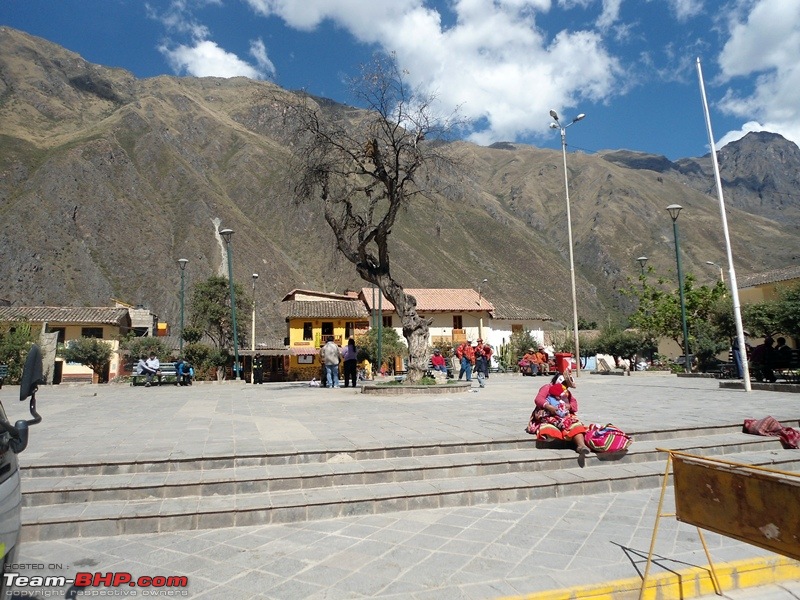 Shops at the main square 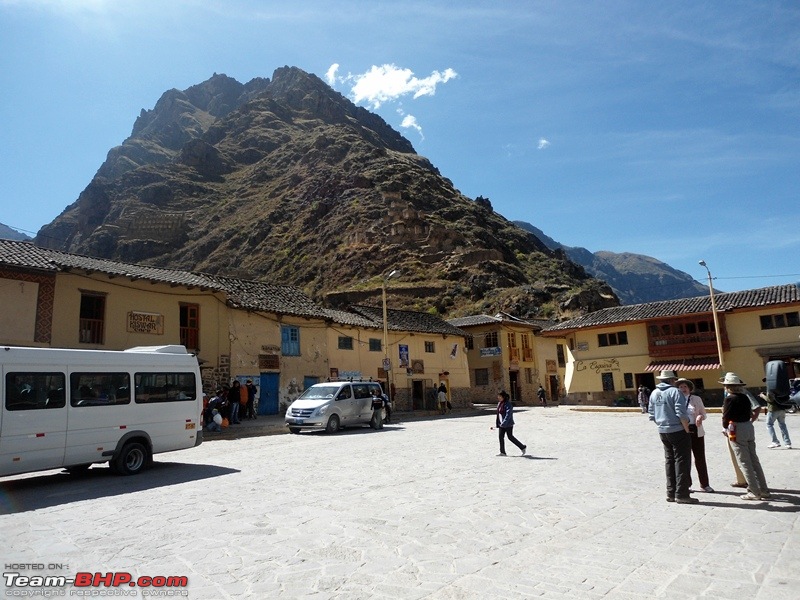 The ruins at Ollantaytambo above the town 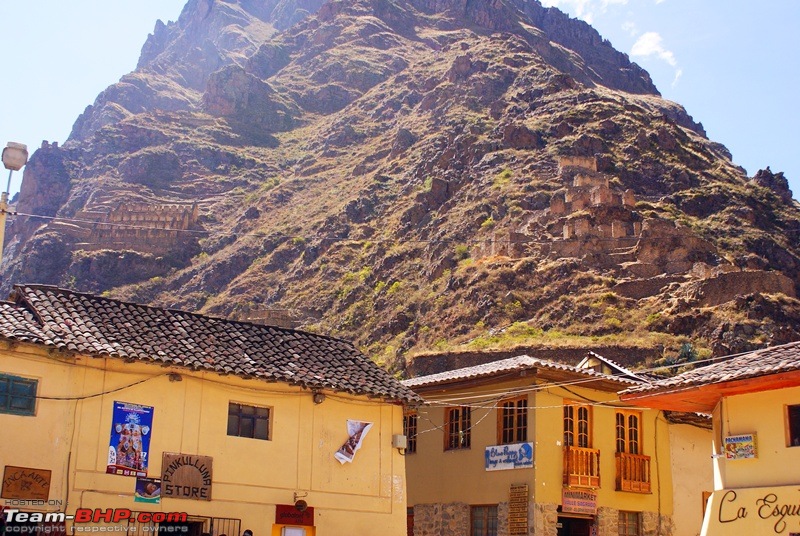 The drive to Moray through the countryside of the Sacred Valley 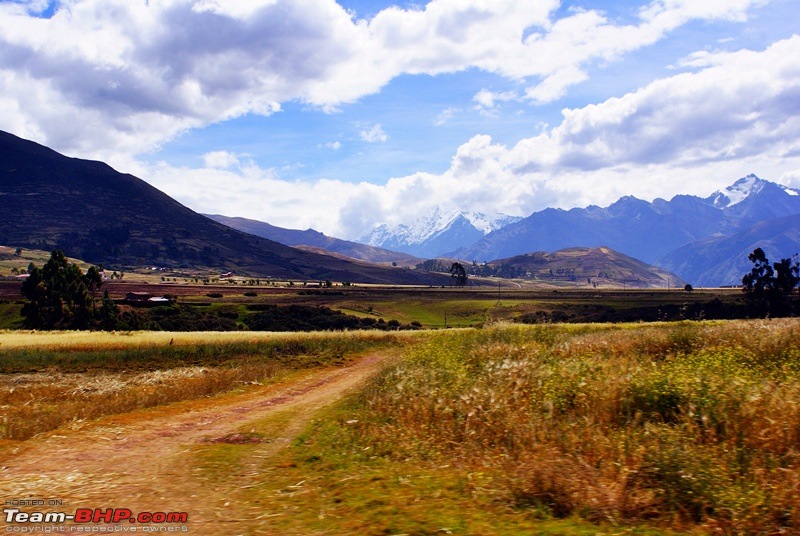 The agricultural fields surrounded by high mountains 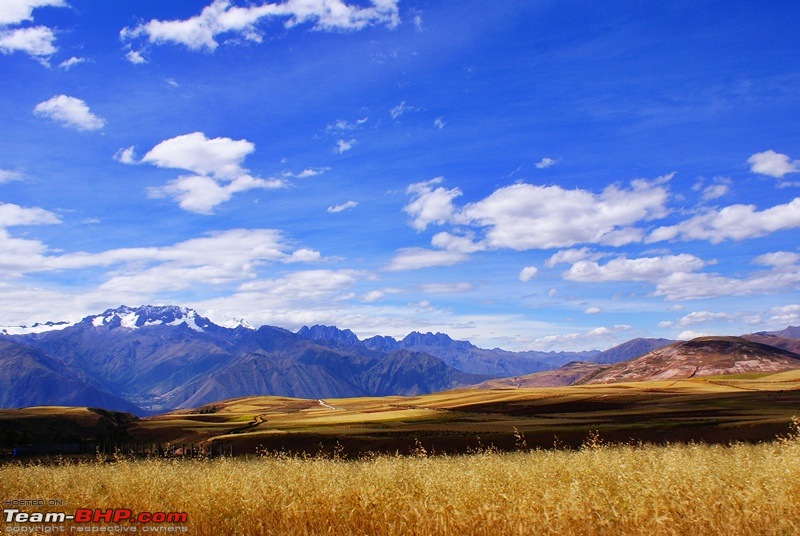 MORAY We reached Moray and went to buy the entry tickets for the site. The entry ticket for Moray can be bought solo as well and there is no need to but a Boleto Touristico full or partial. Solo entry ticket for Moray is priced at 10 soles. Moray is an unusual Inca site and a refreshing change from all the ruins of houses, palaces and forts that are found everywhere. Moray is a deep amphitheatre of terraces. different layers of concentric terraces are carved into a huge earthen bowl. Different layers of terraces have their own micro climate depending on how deep the terrace is in the bowl. This micro climate of each terrace gives it a different character and their depth and orientation with respect to wind and sun creates a temperature difference of as much as 15 °C between the top and bottom. Thus it is believed that these concentric bowls at Moray were used by the Inca’s as their agricultural experiment site. As we were walking along the circumference of the bowls I decided to go down till the bottom. I had seen a lot of tourists going down till the bottom and having their picture s clicked. I must have reached half the distance and I was whistled upon and unceremoniously turned away by the security guard. Actually due to the heavy rains in the area and a lot of tourists influx to the ruins at Moray, the eastern side has already collapsed once and been damaged. Hence the authorities are taking extra precautions. Moray being at a height of 3500mtrs, it was quite tiring going down about 50 feet and then climbing back up again but it was fun. Our 45 minutes at Moray was over and next we were to visit Salinas. The time spent at Moray was definitely worth it. Pics At Moray Concentric terraces at Moray  Terraces at Moray with damaged eastern side 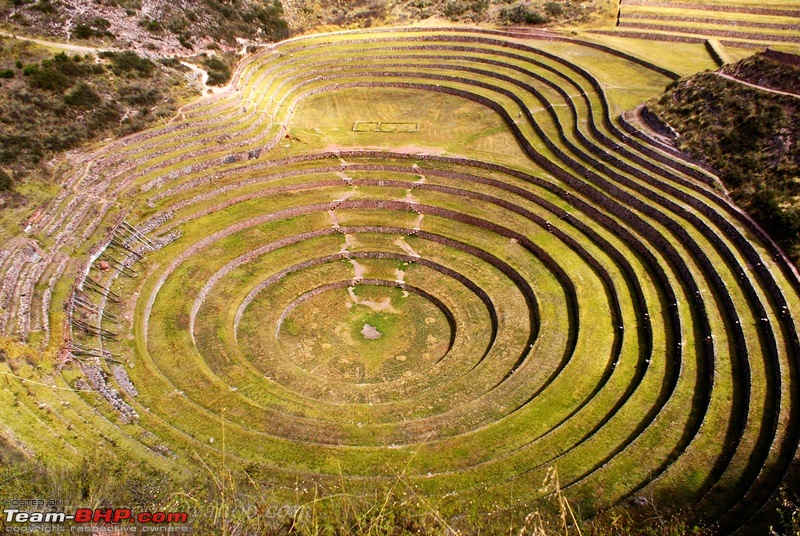 The terraces at different levels and Can you spot me trying to go to the base? 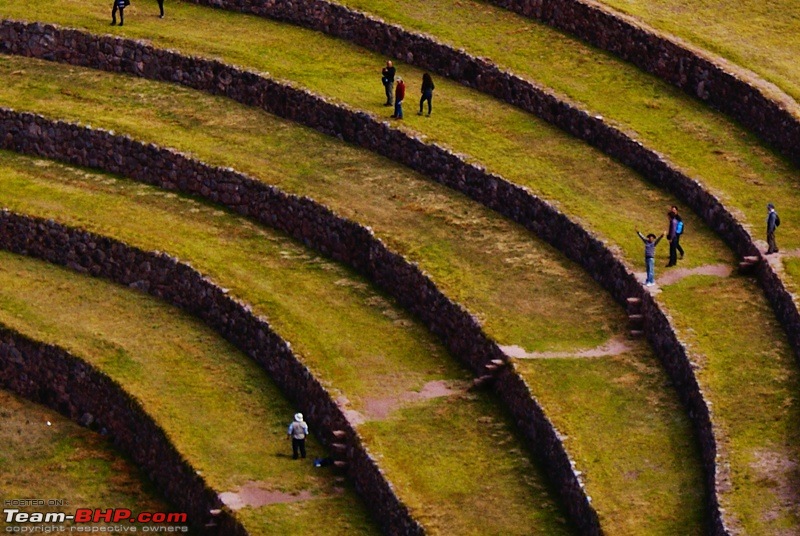 At 3500 mtrs it was tiring going down and back up but worth all the effort  SALINAS de MARAS Next was the visit to Salinas. Salinas is an Inca salt producing site very close to the village of Maras hence also called Salinas De Maras. Here a hot water spring at the top of the mountain discharges a small stream of heavily salt laden water. This salt water is then directed in thousands of pans and salt is produced as the water evaporates from the pans. The different colours of the water in the pans how the density of salt. More than human consumption this salt is more used as salt licks for cattle. The cooperative that run the Salinas issue tickets here and each ticket is priced at 10 soles. You can walk along the pans and see the locals harvesting salt or cleverly directing the flow of the stream to different pans. again a place worth visiting. NOTE: Salinas can also be visited by treking on a small trail from Urubamba directly Pics from Salinas The small little village of Maras  Thousands of salt pans producing salt  A closer look at the salt pans 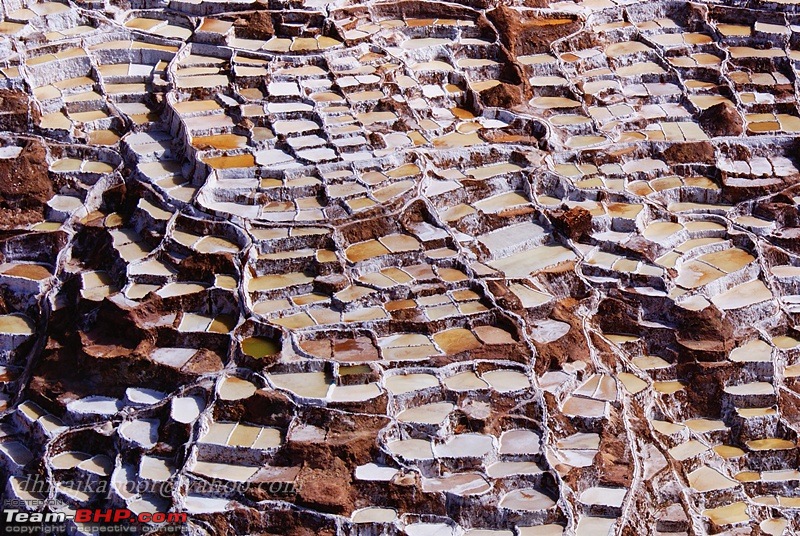 The salt pans and the stream on the right that carry's water from the spring  Locals harvesting salt 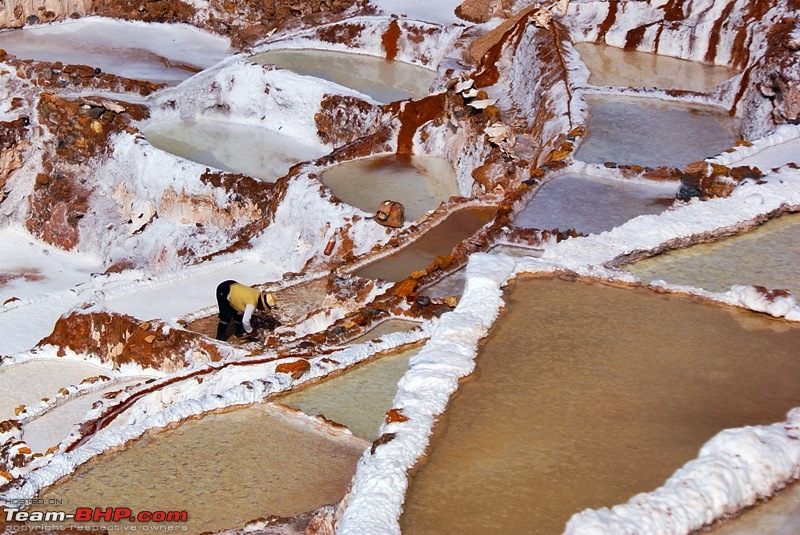 Pans with different hue and colour depicts the density of salt 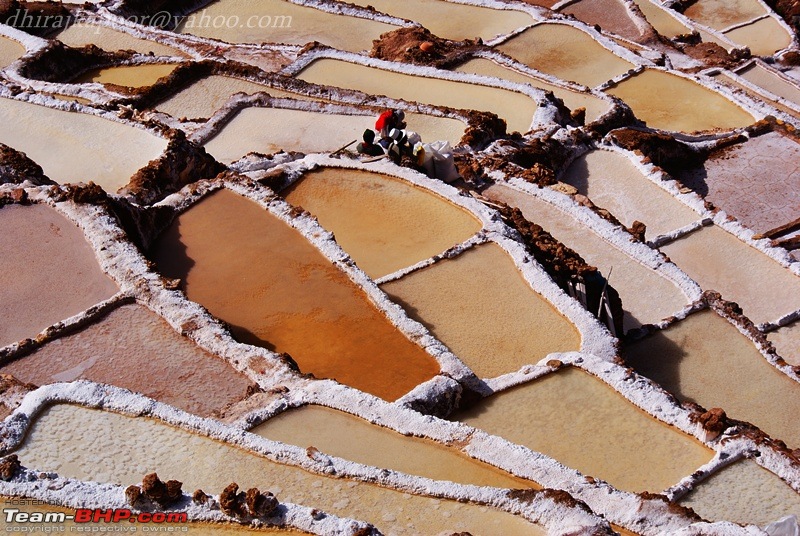  The locals cleverly direct the stream with salt into pans  Another look at the pans 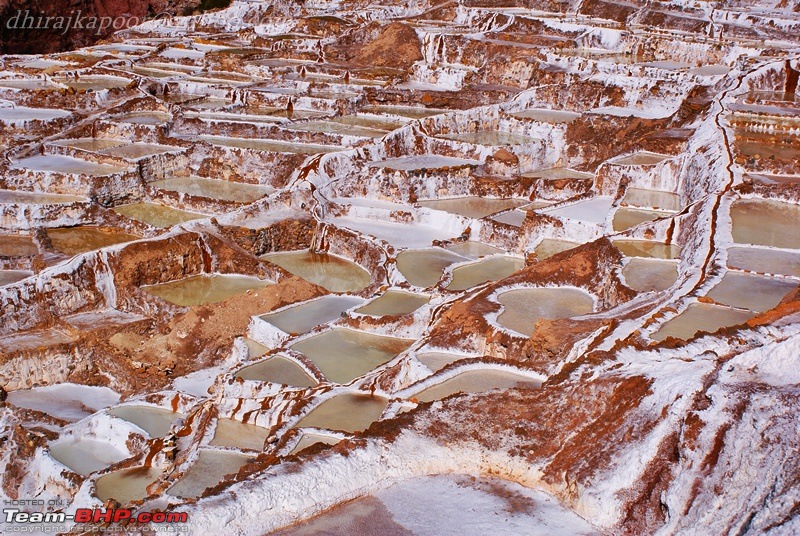 Salt- the product   After finishing Salinas it was time to head back to Moray turn off  After finishing our trip at Salinas it was time to head back to the Moray turnoff to make our way back to Ollantaytambo. We were thrilled with both the places that we had visited today because these were historic yet not the regular ruins that one see’s. At Moray turn off I almost forgot that here the vehicles run on the wrong side of the road and instead of catching a bus to Urubamba I almost got on a bus going in the opposite direction to Cusco. But was saved just in time. Finally we hailed a bus heading to Urubamba and within a few minutes reached. URUBAMBA Urubamba has no historical importance as it is only a transport hub. Yet it is an important town because for going to the other places in the Sacred valley tourists have to pass through it, hence it has loads of resorts, hotels and also restaurants. We hadn’t had our lunch and we were very hungry. We saw a buffet restaurant and went to enquire. The buffet spread was huge but the cost of 30 soles per person was not justified as it was closing time and I would say atleast 25% of the dishes were not available or had finished. The manager himself offered us a 50% discount for the rest and we happily accepted and had a heart meal. There was nothing much to do in Urubamba so we just visited a supermarket, bought some stuff and returned back to Ollantaytambo by the evening. This was one of the best days spent in Peru!!! |
| |  (3)
Thanks (3)
Thanks
 |
| The following 3 BHPians Thank deky for this useful post: | BlackBeard, dailydriver, yosbert |
| | #70 |
| Senior - BHPian Join Date: Jul 2008 Location: Jaipur
Posts: 1,194
Thanked: 1,247 Times
| Re: To the Lost City of Incas - Peru on a Budget! 01/06/2013 : Ollantaytambo & Inca Rail from Ollantaytambo to Augus Callientes (AC) The day can be divided in two parts. Post lunch we had plans to laze around in Ollantaytambo and if we felt like we would visit the ruins around Ollanta. We were not that keen on the ruins as frankly speaking we felt that we had already had an overdoze of ruins in Peru, plus we wanted to leave whatever novelty factor was left for the most famous of the ruins and that was Machu Pichu. In the second part of the day, that is after lunch we were supposed to take the train to Aguas Calientes (also known as Machu Pichu Pueblo). The town of Aguas Calientes is at the base of Machu Pichu and because Machu Pichu has no accommodation (except one very expensive hotel) most of the tourists have to pass through AC while visiting Machu Pichu. Ollantaytambo and around Considering the fact that we didn’t have much to do in the first part of the day, we still ended getting up quite early. After our breakfast we had nothing much to do so I decided to take a walk around Ollanta, just to soak in the local way of life. My wife decided to stay back at the hotel and relax. As told earlier Ollanta has a few Inca ruins of its own. The big ruins those are just across the town on the other side of the River Urubamba were the last and the largest defense structures in the plains before the Sacred city Of Machu Pichu. The Inca’s defeated the Spanish here hence halting their advance to the Sacred city. These ruins were of equally important religious reasons than for security reasons. The huge steps at the ruins still guard the temple that is right on top of the hills. On the hill behind the town has the ruin of “Pinkullyuna” These were basically huge storehouses build on the hill. The idea of building them at a height was that it was more airy and the temperature was also cooler here. While walking around the town I decided to hike up to these storehouses. Finding the small narrow trail up, through the maze of houses was a bit difficult, but I finally managed to find it. First few hundred meters of the climb was fine but as I went up the trail got narrower and more difficult. Infact the trail was over loose stones and boulders. But as I went higher I realized that the view of the town below and the view of the ruins on the other side got better and better. After about 45 mnts of hard climb I managed to reach the top. I rested for a while soaking in the views and it was time to get down and head back to the hotel. Pics from my morning walk Narrow cobbled streets of Ollanta 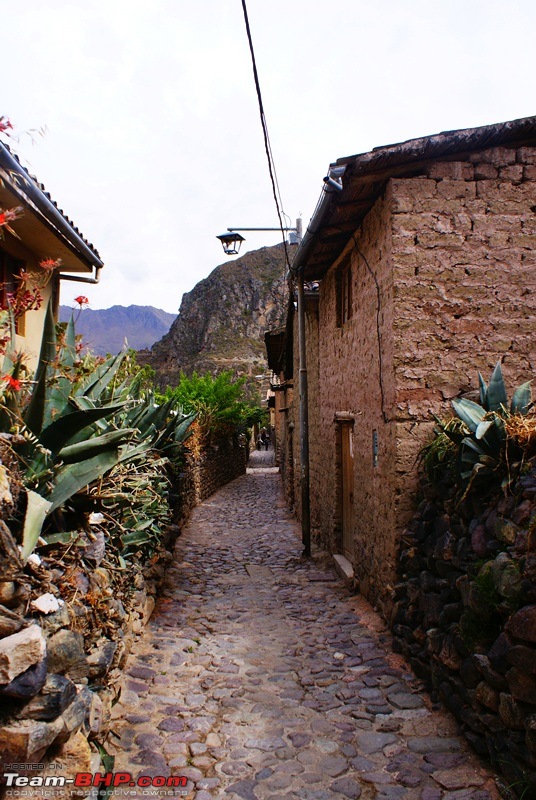  Stone walls are still the same as used in the Inca Period 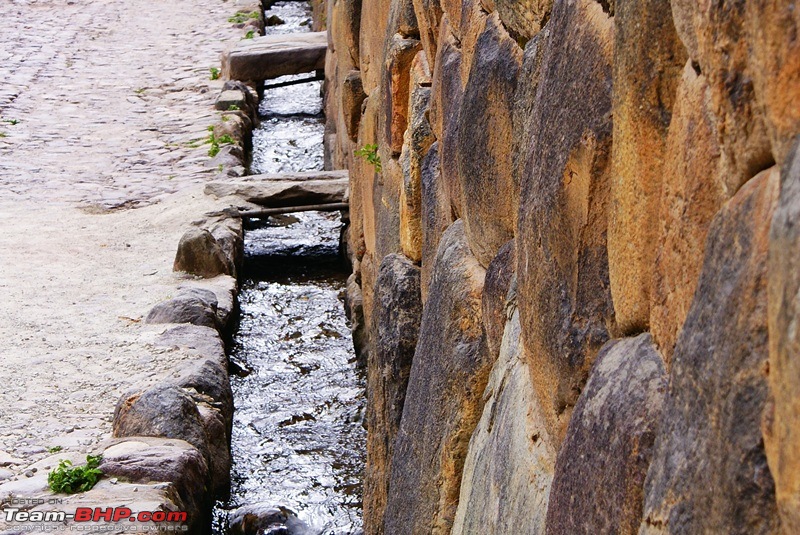 Ruins of Pinkullyuna as seen from Ollanta 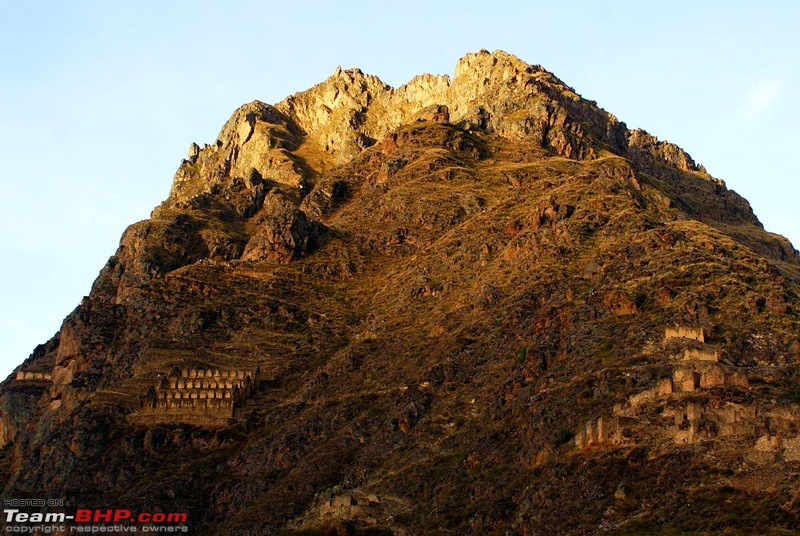 A closer look 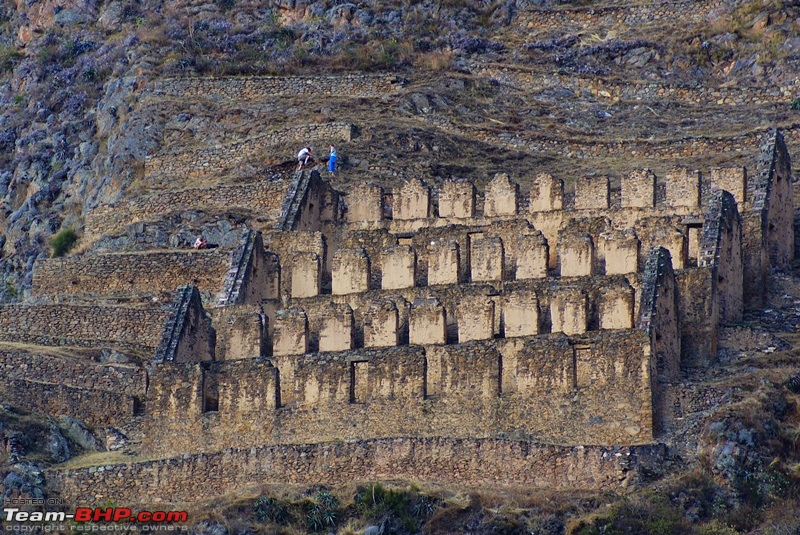 As I started to climb the views of the town and the ruins across 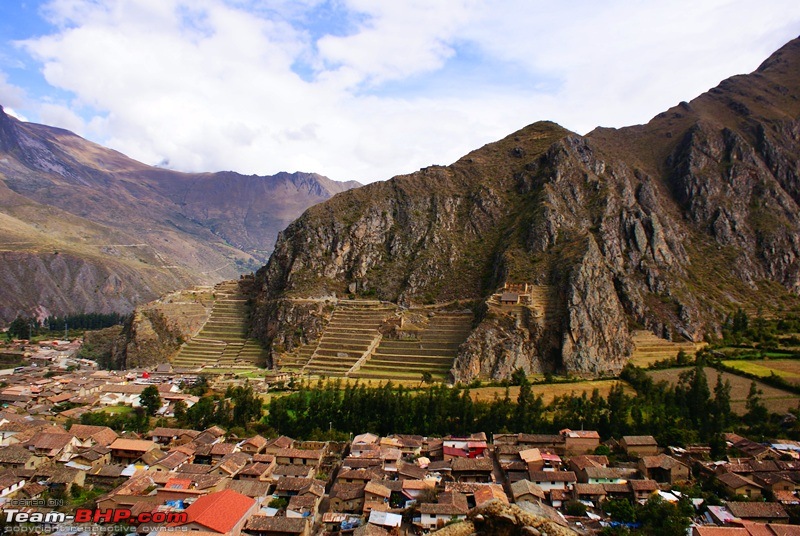 The narrow rocky trail leading to the storehouses 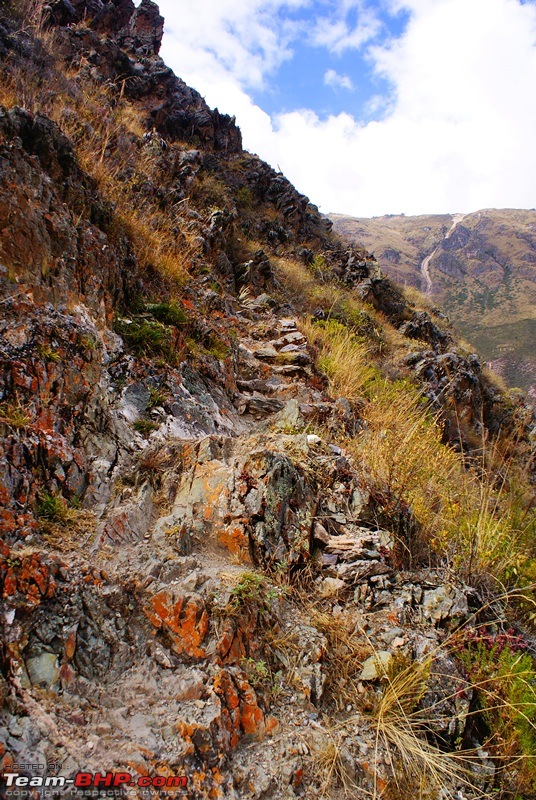 The storehouses on the mountain 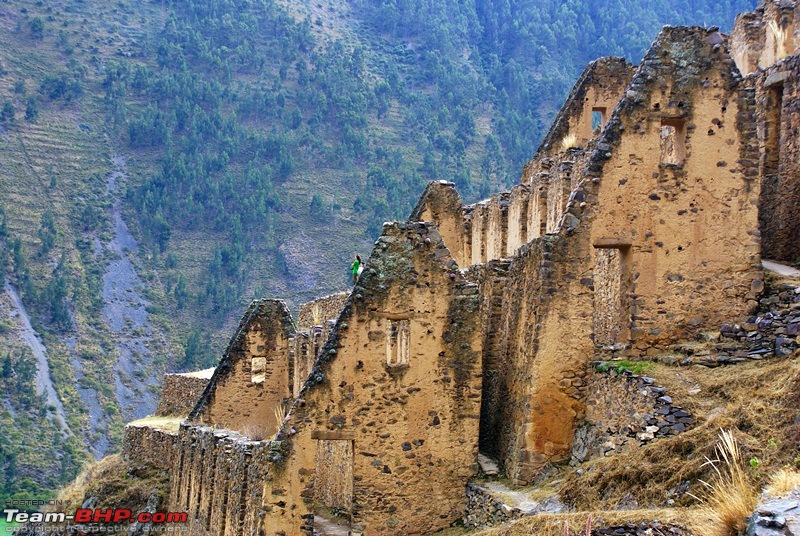 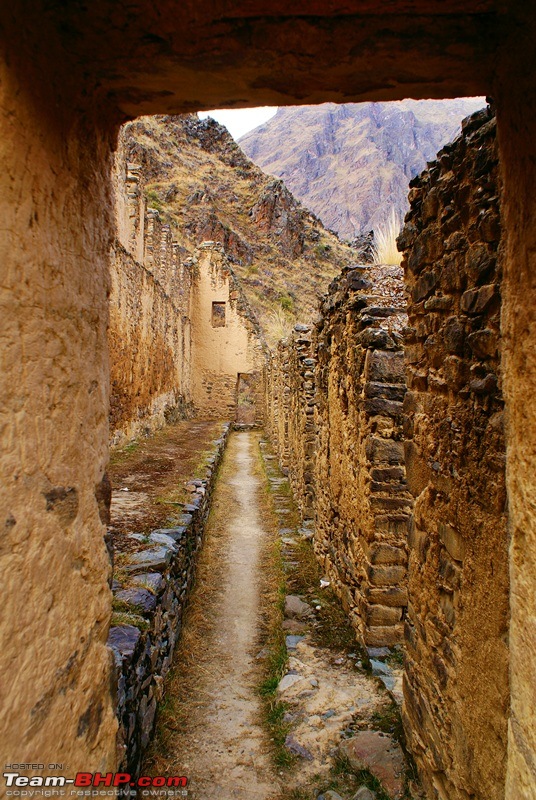 A look at the ruins on the other side of the town 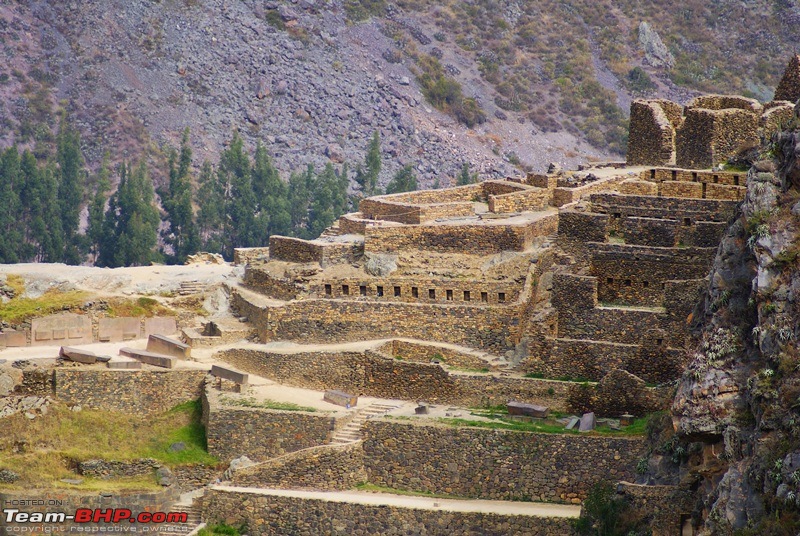 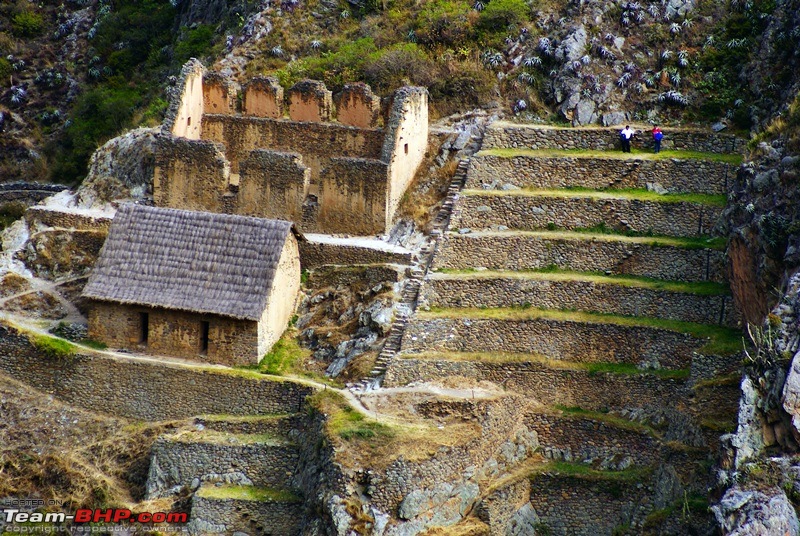 Huge steps at the base guarding the ruins 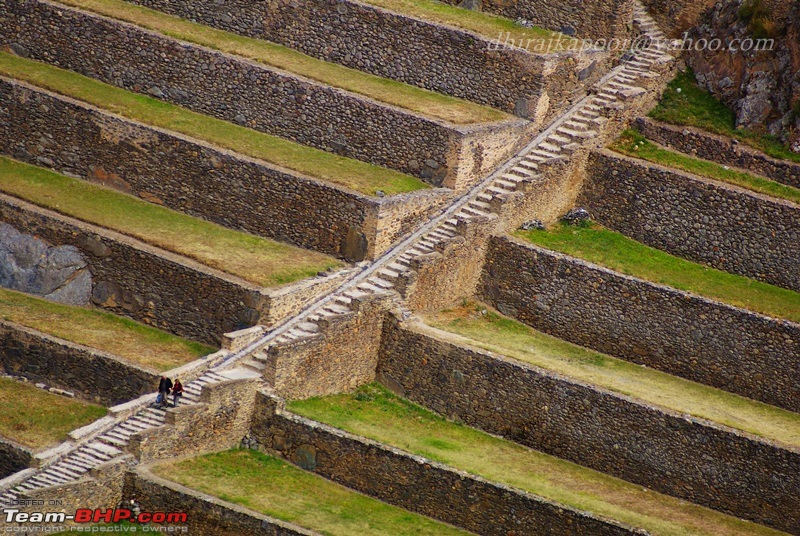 Locals going about their daily routine at their farms  Back at the Resort : Some pics of our beautiful Resort 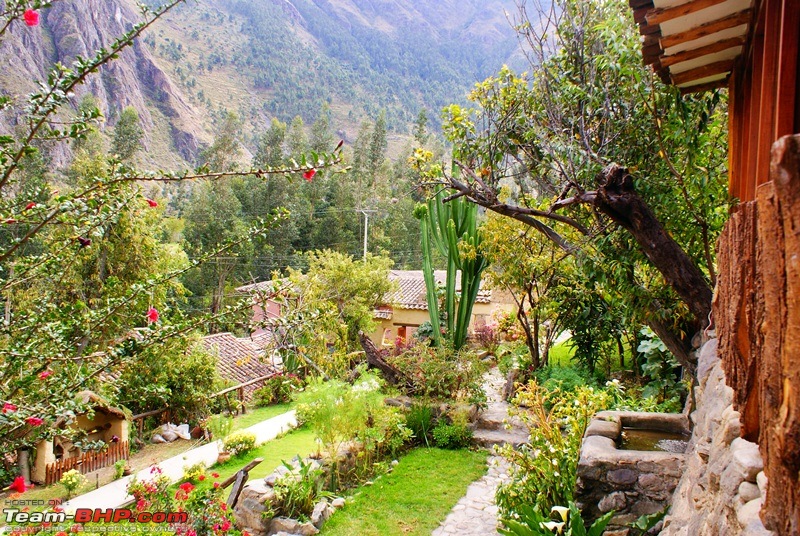 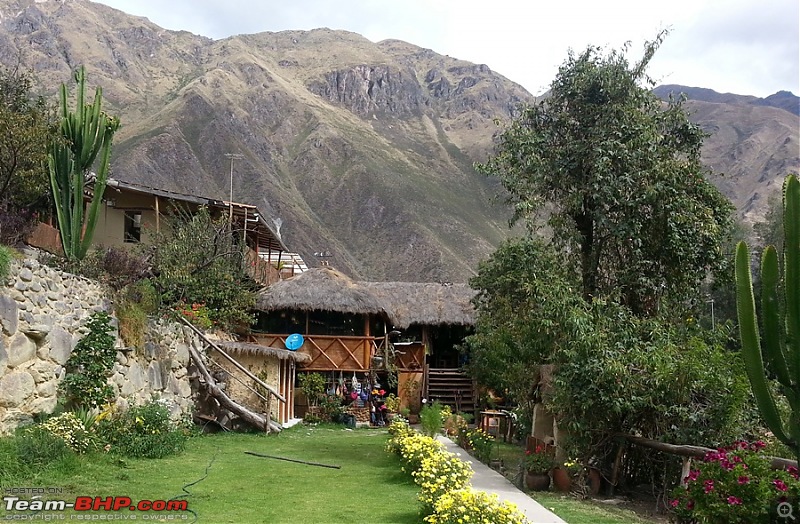 The cottages (pic clicked the previous evening)  Back at the hotel it was time to check out. Though we had booked in the same hotel when we return from AC after our Machu Pichu Trip tomorrow, but they had already informed us that they could not honour our booking due to some internal issues so they would upgrade us to a better and a more expensive hotel in the vicinity. We were fine with that as it wouldn’t cost us extra plus staying in a plusher hotel is always nicer. As we were just going to MP for a day so we were also not taking our whole luggage and the resort staff told us that they will also shift our luggage in that hotel before we arrive. So that was also pretty convenient. After checking out of our resort we decided to have our lunch. After lunch we still had time to kill before our train so we just walked around Ollantaytambo. While doing my research I had read at a lot of places that AC is an overgrown touristy town and tourists having no choice but to go via AC to visit Machu Pichu has become frightfully expensive. Everything from food to drinks and souvenirs is atleast three times the price as compared to Cusco or Ollantaytambo. So a lot of places on the net advise tourists to buy snacks and drinks from Cusco or Ollantaytambo itself. That’s what we did, only to realize later on reaching AC that it’s not that bad. The train station was only a 10 minutes’ walk from the main square and because we only had a small bag pack each on us it was not that bad a walk. Our train was to leave at 1545 hrs and by 1445 we were at the station. Pics So Far While waiting at the reception to check out, this friendly cat decided to sit on my lap 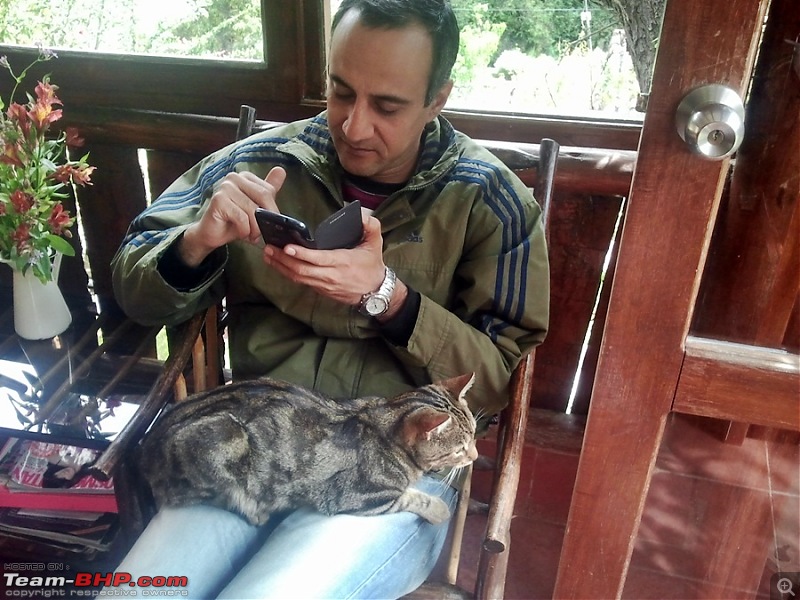 The bell tower of the cathedral at Ollanta 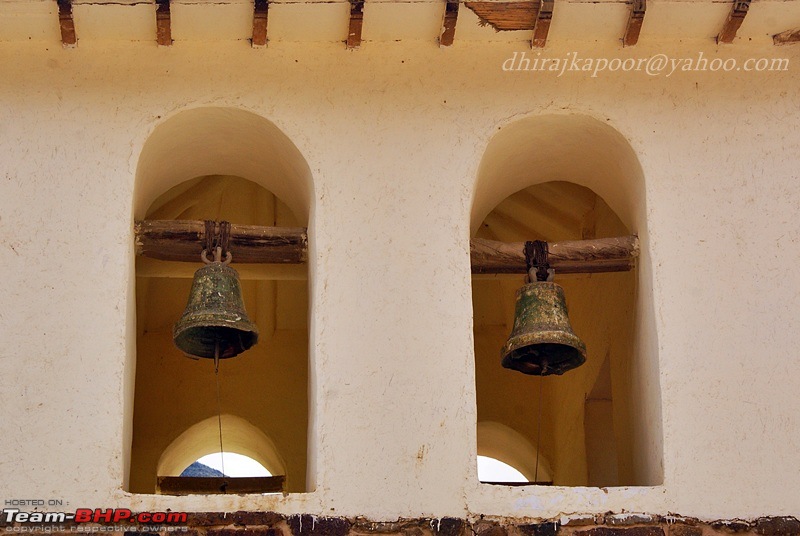 A totempole stick  Nice walk along the river to the train station  Ollantaytambo Train station 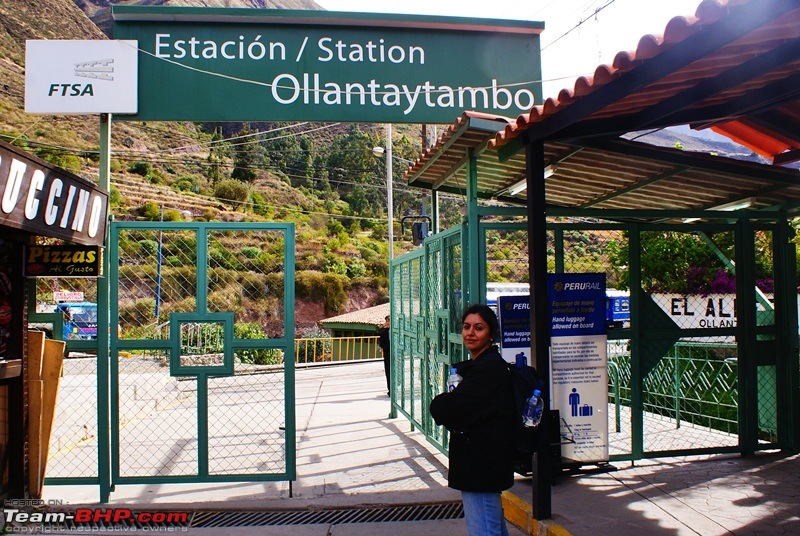 Waiting for our train to come  This is the direction that we have to go. Some where far ahead in the valley lays Machu Pichu  Here comes our train 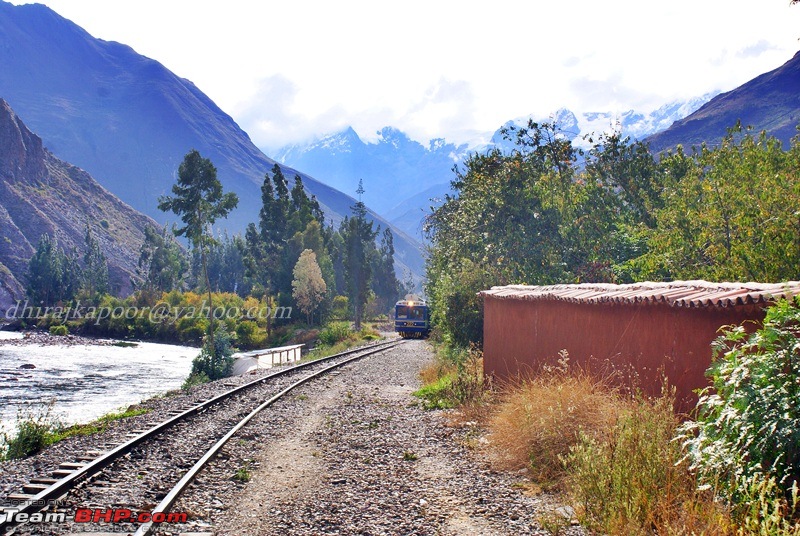 Happiness as we finally were to get to Machu Pichu 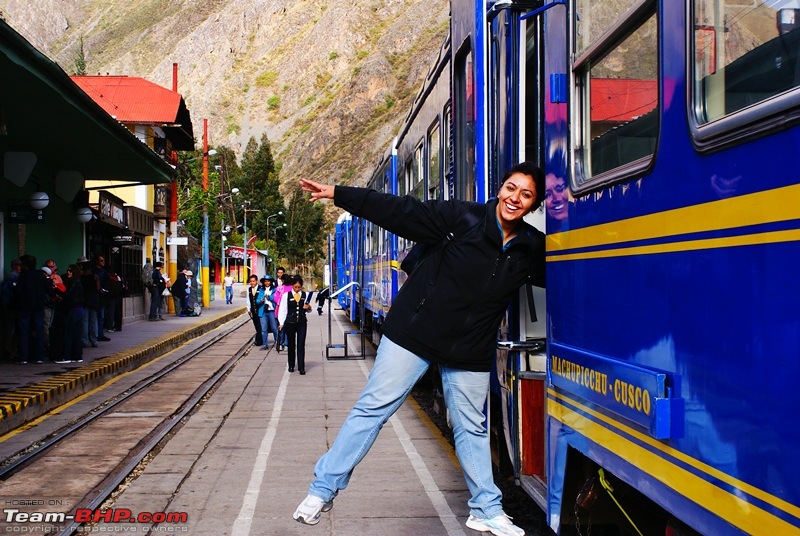 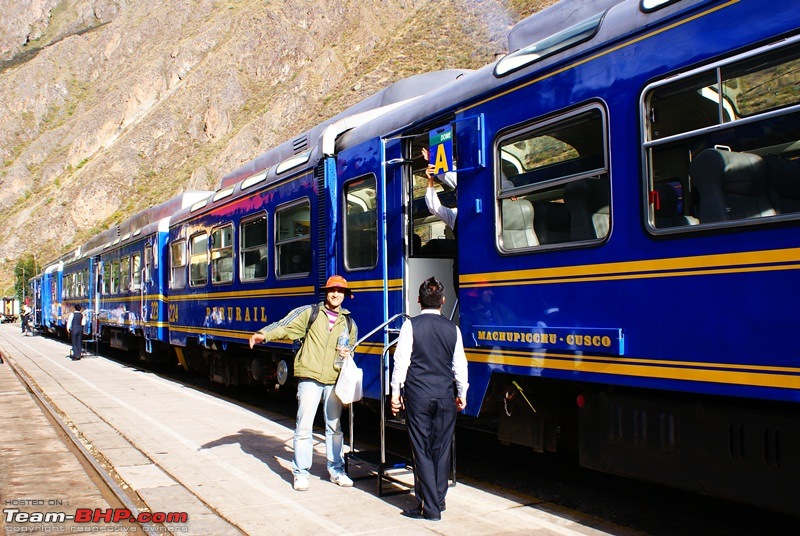 To Be Contd.: Train journey from Ollantaytambo To Aguas Calientes |
| |  (6)
Thanks (6)
Thanks
 |
| The following 6 BHPians Thank deky for this useful post: | BlackBeard, dailydriver, narsi_6989, nkapoor777, sameer sultan, yosbert |
| | #71 |
| Senior - BHPian Join Date: Jul 2008 Location: Jaipur
Posts: 1,194
Thanked: 1,247 Times
| Re: To the Lost City of Incas - Peru on a Budget! HOW TO GET TO MACHU PICHU RAIL Peru Rail and Inca Rail are two privately owned train companies that run trains between Cuzco and Machu Pichu (AC). Ollantaytambo (also referred to as Sacred Valley) is one of the stops in between. During or just after monsoons when the train track is under repair, then trains only run between Ollantaytambo and Machu Pichu and hence there is no service from Cusco. These trains usually get booked days in advance so it’s best to book them as soon as the plan gets final. Plus the earlier you book, the better the chances of getting a better rate. Tickets for both these companies can be booked online and the process is very simple These tourist trains mind you are really very expensive. A single journey from Ollantaytambo to Machu Pichu can cost upwards of 60 USD and go upto 500USD, depending on the class you are travelling in. It will be a lot more if you take the train from Cusco. Just to give you a comparison of the price, a train for locals (Peruvian nationals) costs less than a dollar between the same stations but its illegal for foreigners to travel in trains meant for locals. TREK Trekking to Machu Pichu is quite popular with foreigners. Lots of local agencies organise 4 days or 2 days trek originating close from Ollantaytambo and ending at Machu Pichu. The most popular of the treks is the Inca Trail trek and it has to be done via an authorized agency. For this trek one needs to book months in advance as only limited permits are issued by the government for this. There are other similar treks that can also be done independently like Salcantay Trek Here is a map of the trek routes 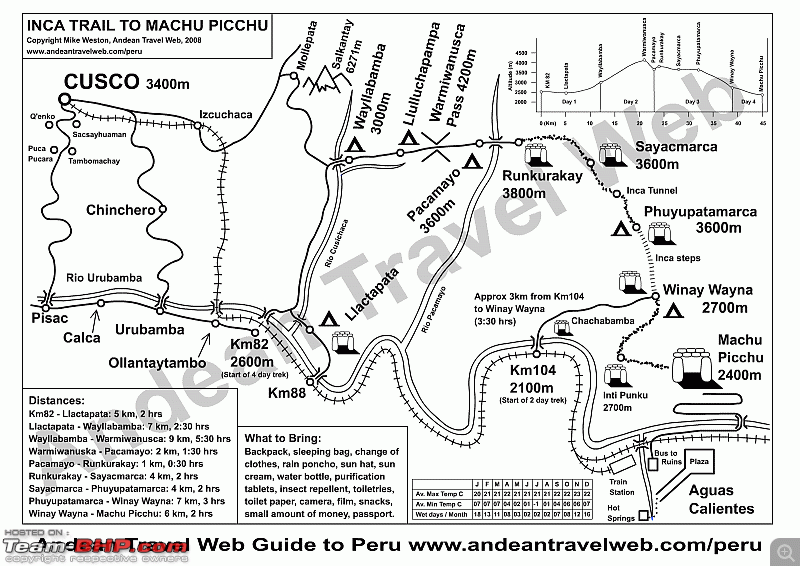 Map Courtesy Andean Travel MINIBUS/HIKE The cheapest yet the longest way to reach MP is to catch a minibus or a collectivo from Cusco/ Ollantaytambo to a Hydro-Electrica via villages of Santa Maria and Santa Teresa. Its also known as the backdoor route to machu Pichu. This route is narrow, unpaved and highly adventurous. It can be fun in good weather but in rains it can be suicidal. Hydro Electrica as the name suggests is a power station located close to Aguas Calientes. This journey from Cusco takes around 7 hrs. Then from the Hydro Electrica one has to walk on the railway track for about 15 kms (which is actually illegal) to reach AC. This hike on the rail track takes around 3 hrs. The total trip would cost around 13 USD for single side. AGUAS CALIENTES TO MACHU PICHU By Bus For those arriving by train or via the back door route there are busses that run between AC and MP. These buses start early in the morning at 0530hrs and leave when full. Given that the rush for MP is very high the frequency is also very high. This 8 km journey that slowly winds up the mountains around many switch backs takes around 30 minutes. For those who want to reach early in the morning to MP for the sunrise should atleast plan to reach the bus top at 0400am as the que is the longest in the morning. The bus ticket for a round trip is 19USD. But you can also by a one way ticket at 10USD. By Foot. One can also walk up to Machu Pichu instead of taking the bus. Either one can walk on the bus route or take the steps that connect the switchbacks. The hike up is long and strenuous and according to your fitness levels can take anywhere between 1 to 3 hrs. Coming down is relatively easier. |
| |  (3)
Thanks (3)
Thanks
 |
| The following 3 BHPians Thank deky for this useful post: | BlackBeard, dailydriver, yosbert |
| |
| | #72 |
| Senior - BHPian Join Date: Jul 2008 Location: Jaipur
Posts: 1,194
Thanked: 1,247 Times
| Re: To the Lost City of Incas - Peru on a Budget! 01/06/2014: Train Journey from Ollantaytambo To Aguas Calientes I had pre-booked our journey on the train before hand on the net. So all we had to do is reach the station and wait for our train to arrive. Coach number and seat numbers are already provided on the ticket itself. I had read on the net that this 40 kms odd journey passed through scenic mountains and beautifull natural vistas so I wanted to make sure that while going we would go during day light so that we could enjoy the scenery. We were traveling by Peru rail. There was no reason to pick Peru Rail over Inca Rail except the fact that the timings of Peru Rail suited us better. Infact what I had planned was that we would go with Peru Rail and on the return take the Inca Rail back. But that plan backfired because when after getting the onward journey tickets done on Peru Rail, when I got down to book Inca Rail for the return, the Inca Rail server did not let me book just a single leg journey. So for the return also I had to book Peru Rail. And I did loose on some money because if I had booked both the journeys with one operator I would have got some discount. I had booked Vistadome train with Peru rail. Vistadome is the class of train which is higher than the Expedition Class but way lower than the Hiram Bingham Luxury Class. Vistadome like Expedition has panoramic windows and glass on the ceiling as well so that tourists can enjoy uninterrupted views and opportunities to click pictures. Vistadome has a bit better and more spacious seats than Expedition Class and a light snack is also included with the ticket. Over all I would suggest that when checking the prices, do compare the price for both the classes. Usually there is only a 5-6USD difference in both the class but the difference is absolutely worth it. NOTE : Train companies have a baggage allowance of 5kgs per ticket. So plan your luggage for Machu Pichu accordingly. Though on paper they are very strict on this but I have seen tourists carry bigger and heavier luggage without any problem. After some delay our train finally arrived at the station. These trains are like shuttles which keep travelling between Machu Pichu & Ollantaytambo (tracks were under repair till Cusco). Each bogey has its own engine and driver compartment so according to the number of tickets booked, bogey’s can be reduced or added. The driver compartment won’t be more than 4 feet by 4 feet in area so, if you manage to get the front most seats in the front bogey or the last seats in the last bogey, the views get even better. The seats that were issued in this train were separate and naturally we wanted to sit together. So I approached the attendant of our bogey who was kind enough to adjust two seats for us together. But I still wasn’t happy as my eyes were set on seats in the last bogey and since the last bogey was added in the last minute there were plenty of empty seats left in that bogey (front bogey had no empty seats). I approached the attendant of the last bogey and after a few sweet words in my broken Spanish (that I guess didn’t work) and after a meager tip (that definitely worked) we were allotted the last two seats in the last bogie. The best part of the seats are, that they can be positioned facing forward or backward in any direction you want. So now we had seats looking out of the back window with almost 240 degrees ( except the drivers cabin) of panoramic view. The train journey is miserably slow but its totally worth it. It’s a single track and trains do not go more than 40 kmph. There are designated passing points for an oncoming train and believe me that train operators themselves have to stop the train. change track for going on sidings, take the train on sidings, let the other train pass, change track again to go on the main track. This happens more than a few times delaying the trains even more. But the 1 hr and 30 mnts that one spends on the 38km journey is filled with spectacular views so no one minds all this. The train track winds through the narrow valley with River Urubamba aka River Wiilakunta flowing alongside. Initially as one leaves Ollanta, the terrain is mostly dry and one can see snow capped peaks around but as one gradually descends further dry terrain gives way to more greener pastures and then as one reaches closer to Aguas Calientes its all dense jungle. Though walking on train tracks is prohibited, you will find some backpackers risking it and hiking it to Aguas Calientes via the train tracks as well. Pics of the train journey Waiting for the train to start, last coach and last seats 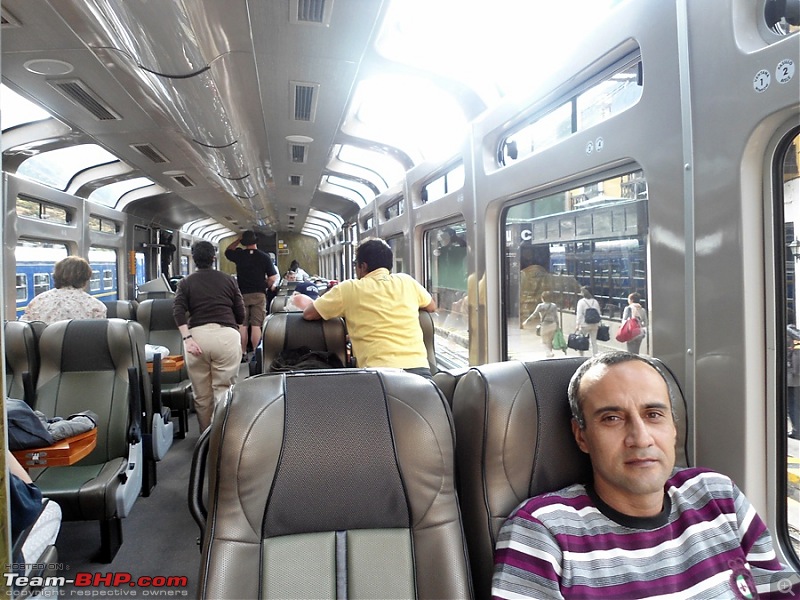 As the train pulled out of the station, view from the last window   Dry barren hills as we leave Ollantaytambo   At a train crossing, the other train belongs to Inca Rail 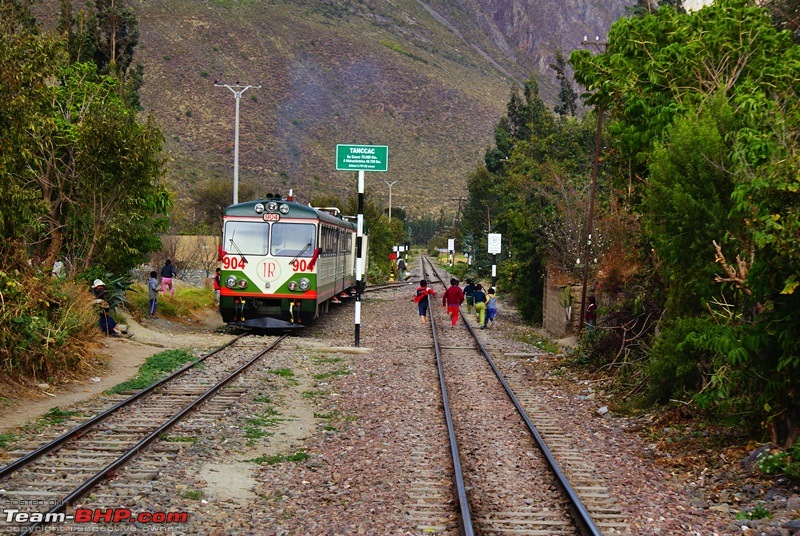 As we descended it got more greener 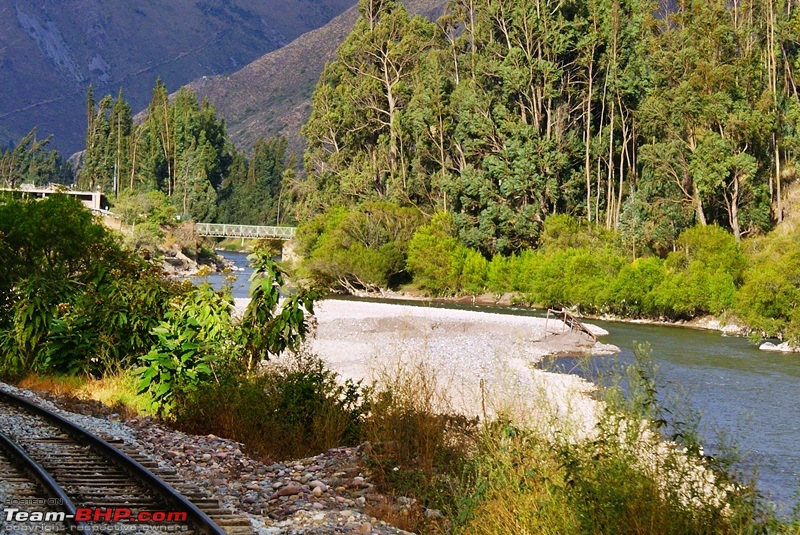 Mountains thru the window roof of the train 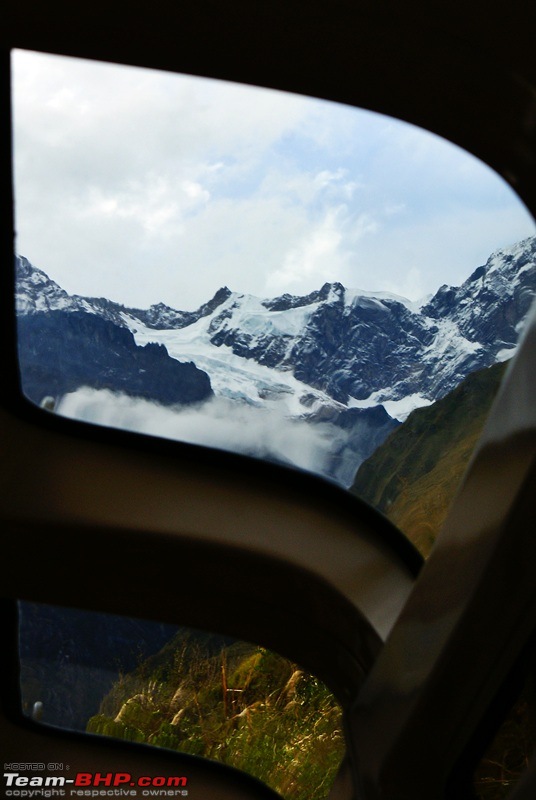 Tracks winding along the hill side  This is the bridge from where the original Inca Trail trek starts 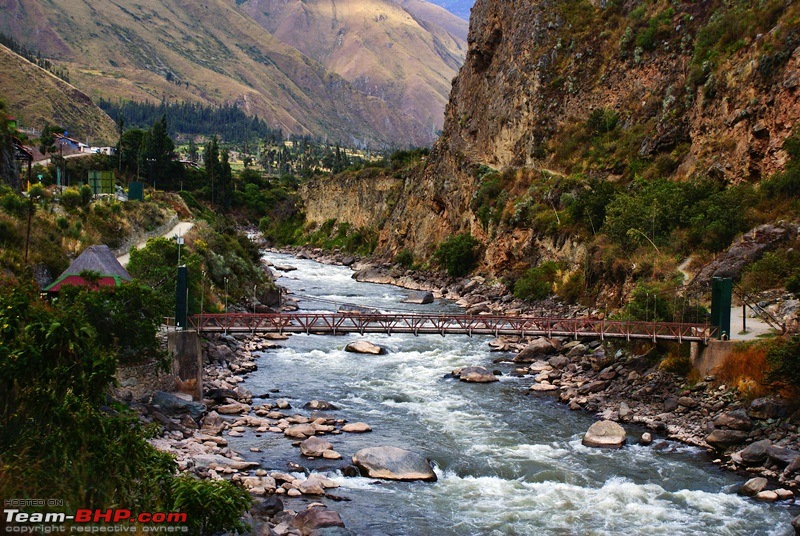 Hikers making their way to Aguas Calientes 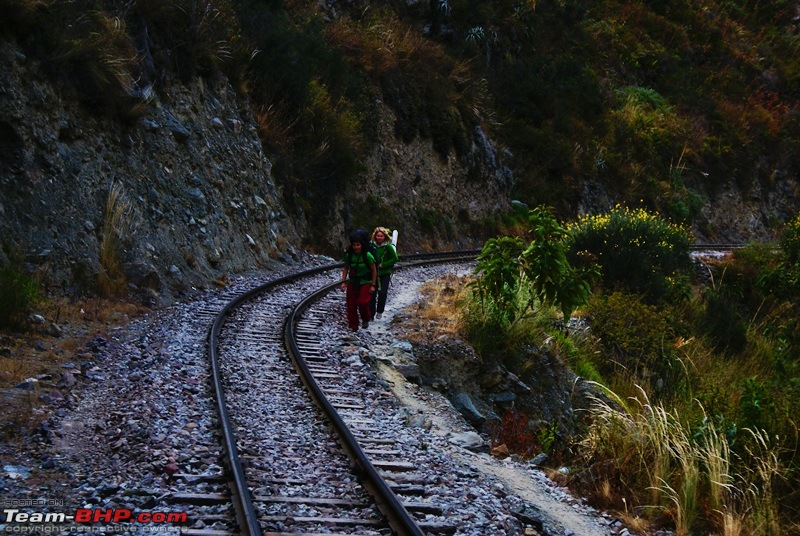 The mountains and the valleys that we had left behind  It got more greener and more beautifull, but it got darker too 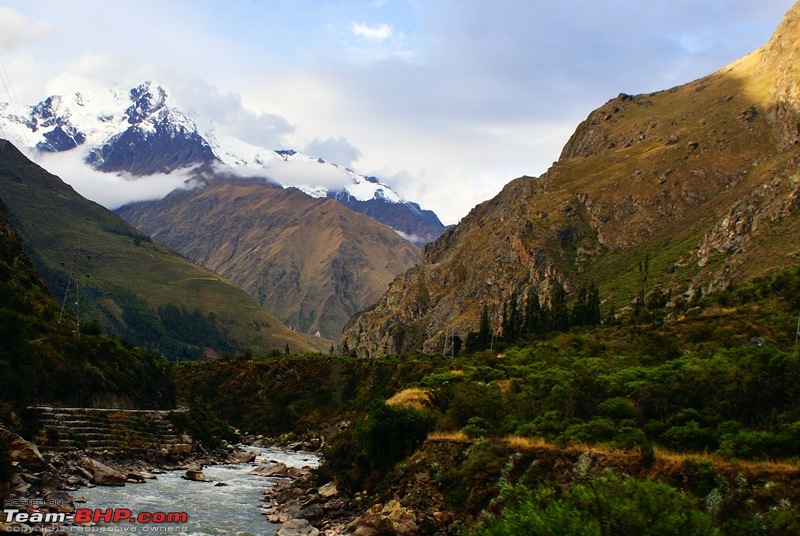 River Urubamba aka River Willkanuta gave us company throughout the route 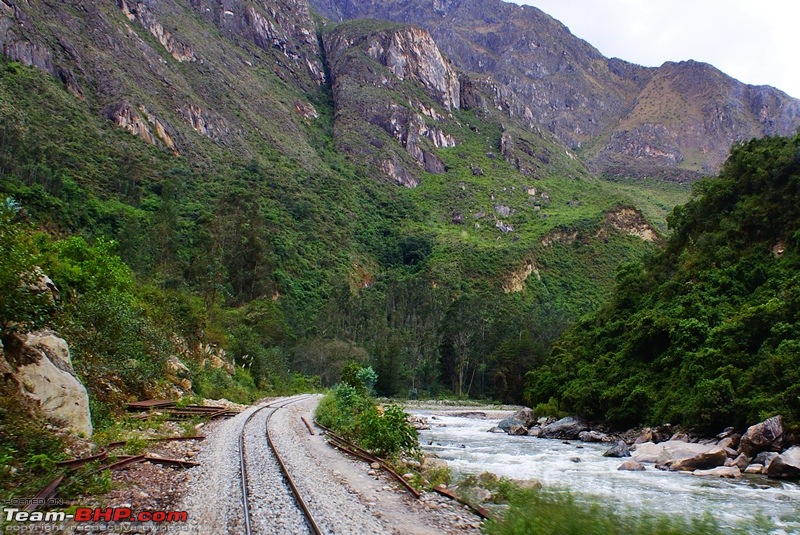 Another train passing, this time it was a single bogey 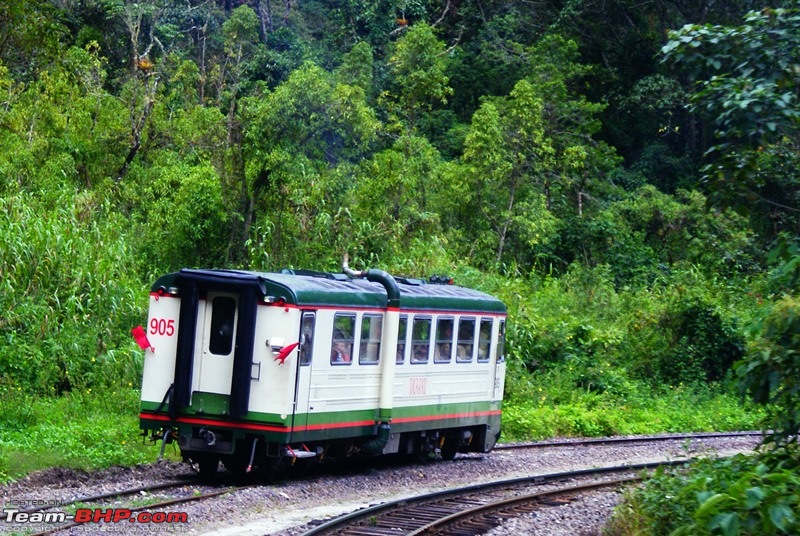 More hikers  A hydro electric dam site as we got closer to Aguas Calientes 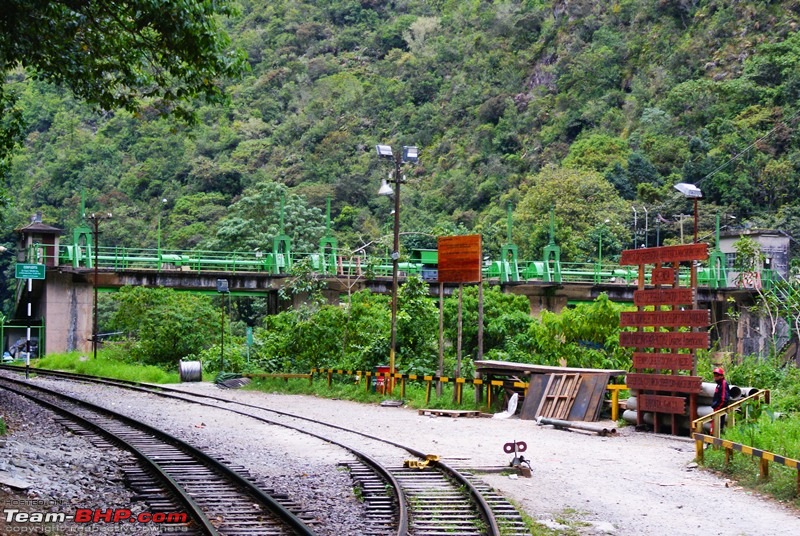 Notice how the barren mountains change to forests with thick undergrowth 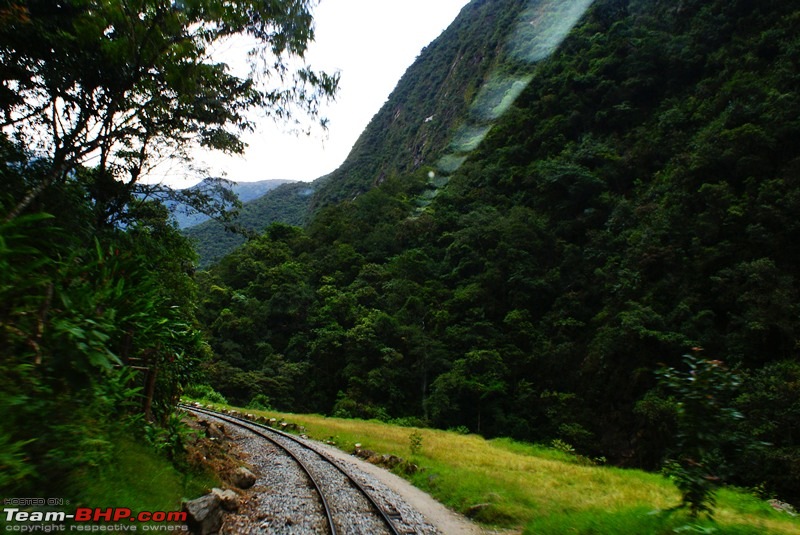 The luxurious Hiram Bingham train stationed at Aguas Calientes station  Next post Aguas Calientes!! |
| |  (3)
Thanks (3)
Thanks
 |
| The following 3 BHPians Thank deky for this useful post: | BlackBeard, dailydriver, yosbert |
| | #73 |
| Senior - BHPian Join Date: Jul 2008 Location: Jaipur
Posts: 1,194
Thanked: 1,247 Times
| Re: To the Lost City of Incas - Peru on a Budget! AGUAS CALIENTES Or MACHU PICHU PUEBLO The Spanish word Aguas (water) Calientes (hot) if literally translated to English will mean a hot water spring. Yes, Aguas Calientes has hot water springs but it’s not famous for that. It’s more known for its proximity to the Inca Citadel Machupichu and it acts as the base for tourists going up to the forbidden city of MP. Hence the name Machupichu Pueblo (village) is also given to the town. Aguas Calientes lies in the deep valley below the ancient Inca ruins and is surrounded by green and high mountains. The setting is spectacular but the town is pretty much chaotic. The proximity to MP and because all tourists going or coming from MP have to pass through the town have to stop by here has made this town into a tourist trap. Unplanned tourist development and perpetual construction makes this one of the ugliest and the most exploitative towns in Peru. The only reason to spend the night here is to catch the early buses leaving for MP for watching the magnificent sunrise or to enjoy the beauty of MP before the hundreds of tourists coming by train from Cusco swarm the Citadel like bees. As we got off the train and moved out of the station, the first thing we had to do was to book bus tickets that would take us to Machupichu the next morning. We wanted to go up as early as possible to catch the sunrise and also to enjoy MP before many tourist came in. The other reason why we wanted to reach early was that we had booked the climb up to Huyana Pichu in the 7am slot. The buses for MP start from 0530hrs onwards and leave as and when full. Because 2500 tourists are allowed per day to MP there is always a que for the tickets. Hence for those leaving early, the best is to buy tickets the previous day to avoid standing in the ticket que. We found the ticket counter right next to the bridge close to the station and got our return journey bus ticket booked. The next part was to look for our hotel and that was turning out to be troublesome. This as explained earlier, was due to the unplanned growth of the town. No one seemed to know where the hotel was. At one point I seriously thought that I was cheated and the hotel doesn’t even exist. But finally after sometime we did manage to find it and checked in. Again it was a good choice of a hotel. The room though was small but was comfortable and the bathroom had 24 hrs of hot water. The caretaker lady was kind enough to also offer us breakfast at 0430hrs the next morning as we had plans to reach the bus stop by 0445hrs to catch the first bus leaving for MP at 0530hrs. It was evening and we went out to explore Aguas Calientes. We realized that here they had much more restaurants in any other town the same size in Peru. Having so many restaurants and cafes the competition was huge and the prices if not the lesser were definitely same than the other towns. So the advice all over the net to carry your food from Cusco was ill founded. What was a bit expensive was bottled water and soft drinks, but not enough to be carrying litres of water from other city. After having Chifa dinner we decided to come back to the hotel and retired for the night as Tomorrow morning was a big day and an early start!! Pics from Aguas Calientes The town of Aguas Calientes. On the left are the green busses that shuttle between AC & MP 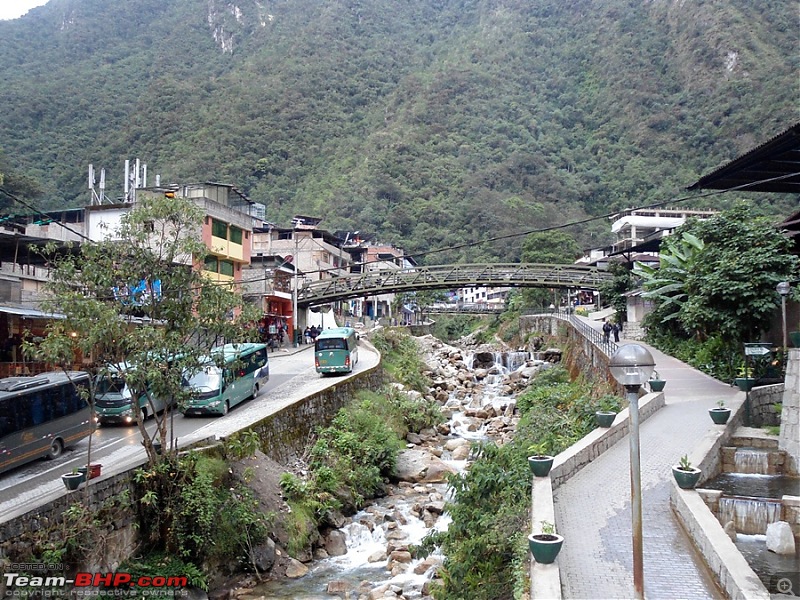 Trying to figure out where our hotel is 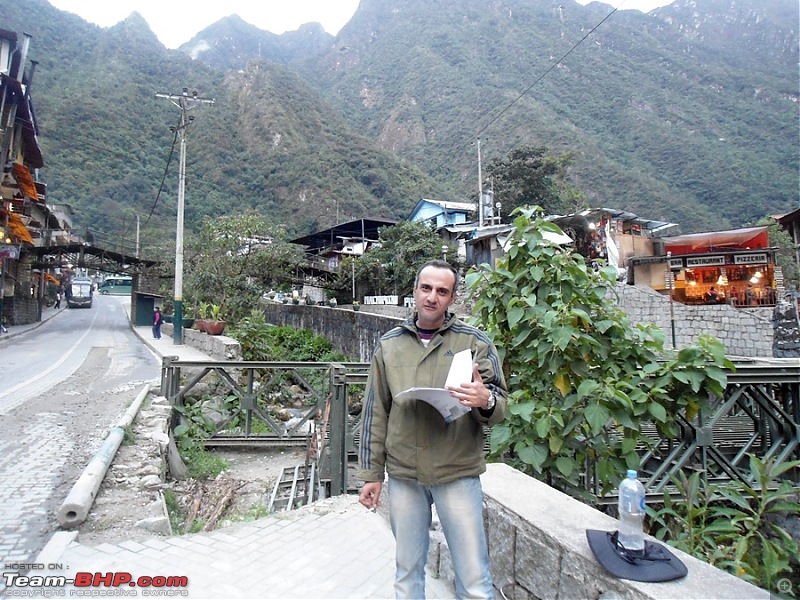 Its totally tourist oriented with cafes, restaurants, bars and souvenier shops  Walking along the streets during evening 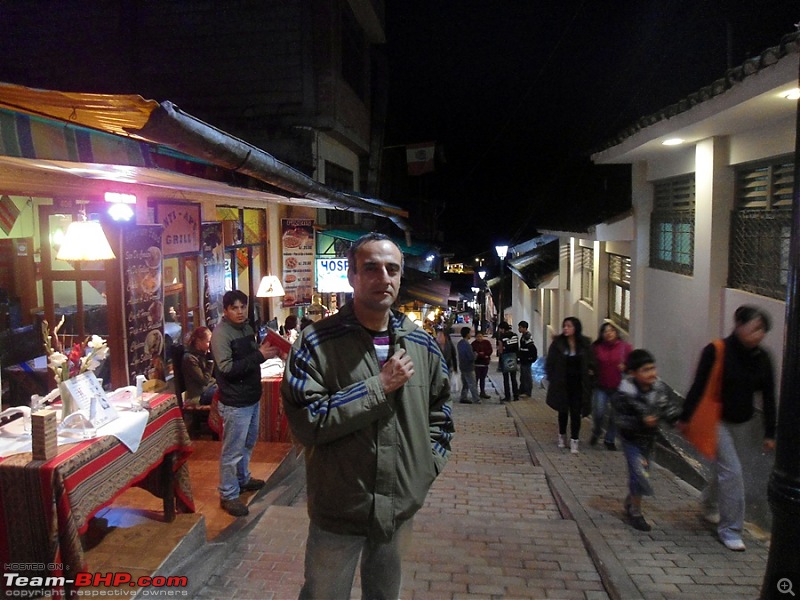 Next Post Machu Pichu |
| |  (4)
Thanks (4)
Thanks
 |
| The following 4 BHPians Thank deky for this useful post: | Akshay1234, BlackBeard, dailydriver, yosbert |
| | #74 |
| Senior - BHPian Join Date: Jul 2008 Location: Jaipur
Posts: 1,194
Thanked: 1,247 Times
| Re: To the Lost City of Incas - Peru on a Budget! MACHU PICCHU- THE LOST CITY OF THE INCA’s I would say Machu Picchu is the main reason for most of the visitors coming to Peru. Visiting Machu Picchu is definitely the highlight of the trip for all the tourists. Machu (means old) Picchu (peak) is an old Inca Site situated at a height of about 2400mtrs above sea level. Because it was forgotten by the outside world and re discovered by an American Historian Hiram Bingham only in 1911 its also called the Lost City. Machu Picchu is considered to be one of the best known archeological site in the continent. Apart from the mystery that surrounds the site, its location on a plateau on a high mountain which is surrounded by deep gorges and more mountains, makes it spectacular and also awe inspiring. HISTORY Machu Picchu was built in around 1450 at the height of Inca Empire. No one knows for certain why the city of Machu Picchu was built and why was it abandoned. The most accepted theory is that due to its formidable location this was the Royal retreat for the selected Inca’s. High up in the mountains, away from any other known city this acted as a place for the Inca’s to relax, hunt and treat their guests. This theory Another theory is that due the mountains being revered by the Inca, this was one of the most important religious sites for them. Also the fact that River Villcamayo (Urubamba) encircles the whole mountain that has Machu Picchu gives this theory authenticity. The position of the Sun, also an Inca God, plays an important role during the solstice. Hence, making this site important. No one knows for certain, why this site was abandoned after 100 years of occupation. Some believe that before the Spanish invaded all the occupants died due to a disease hence this site remained a secret. Slowly over the years thick jungle covered the remains of Machu Picchu and apart from a few locals who knew about it, for rest of the world this place continued to remain a secret. In the year 1911, an American Historian, Hiram Bingham, accidentally found this site. He was apparently looking for another site but accidently stumbled on the remains of Machu Picchu. After a numerous visits and lot of excavation, finally Hiram Bingham presented this site as Machu Pichu – The Lost and The last city of Inca’s to the world. Though Hiram Bingham is credited for re discovering Machu Picchu, but he is also accused of taking all the treasures and all the historically important artifacts back with him to America. These are now displayed at the Yale Museum University. In 1983, UNESCO understood the importance of Machu Picchu and designated it as a World heritage Site. The government is trying to regulate tourism and only allows 2500 visitors per day to Machu Pichu and only 400 per day to the mountain of Huyana Picchu that is within the citadel. Some feel that because Machu Picchu is surrounded by volcanic mountains and also prone to earthquakes, this number is also very high The government has also declared the area around Machu Picchu as a sanctuary and has become very strict on tourism related activity in the buffer zone of Machu Picchu. 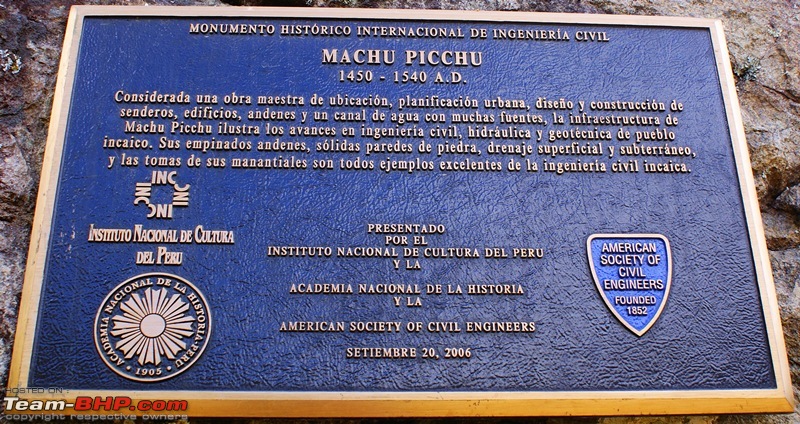 MACHU PICHU PERMITS As only 2500 people are allowed in a day and lot many tourists visit Machu Picchu, this number during the high season is sometimes not enough. So the best is to book your tickets to Machu Picchu as soon as your plan gets confirmed. The Peruvian government regulates the sale of Machu Picchu tickets via its official website (http://www.machupicchu.gob.pe/) though the website is in Spanish and it’s difficult to understand but Google translator comes in handy. Through this website you have a choice to visit either just Machu Picchu or combine it with Machu Picchu museum or you can either climb the Machu Pichu Mountain or climb the Huyana Pichu. Huyana Picchu climb is broken in two slots first being 7 am and the second being 10 am. In both the slots not more than 200 people can go. So if you are keen to climb Huyana Picchu as well then the earlier you book the better it is. Price as of now are as follows :- Only Machu Pichu – 126 Peruvian Soles Machu Pichu + Museum – 148 Peruvian Soles Machu Picchu + Huyana Picchu – 150 Peruvian Soles Machu Picchu + Montana – 140 Peruvian Soles. There are some discounts offered for Peruvian nationals and also to International students on the above rate on producing a valid identity card NOTE: Machu Picchu tickets cannot be purchased at the site itself, so make sure to book your tickets in advance INFORMATION The ruins open from 0600 hrs till 1800hrs in the evening. Spending the night or trying to hide in the ruins is illegal and can have heavy legal repercussions. Though the ruins are open throughout the day but are most heavily visited between 10am and 2pm. This is when hordes of tourists on organized tours coming from Cusco descend on Machu Picchu. Sunday is also a good time to visit as lots of tourists end up going to Pisac instead as the local craft market is the attraction. Sunrise and sunsets are also mesmerizing due to the change in colours and hue that happens. This is why lots of tourists like to reach Machu Pichu early in the morning. April to October is the busiest season for Machu Picchu as it’s the driest. November to March sees a lot of rain. Though it’s at a height of around 2400 mtrs so mornings and evenings are cold but the day can get uncomfortable due to the high level of humidity because of the surrounding jungle. At Machu Picchu entrance they are very strict about security. They will check your ticket against your passport. Officially, you are not allowed to bring any food or water bottles into the park, and must check these in at the luggage storage at the entrance. In practice, however, bags are rarely searched, and most people have no problem getting a small bottle of water and some snacks in with them. GETTING AROUND You can hire an authorized guide if you want at the entrance. They will cost around 20USD for a two hour private tour. You may also join a group and get a concession on the price. But make sure that the group is an English speaking group (considering that you speak English). Though the whole tour of understanding Machu Picchu would take much more than two hours, but the major sites to explore in the citadel are as follows 1. Huyana Picchu 2. Hut of the Caretaker of Funerary Rock 3. Ceremonial Baths 4. Temple of The Sun & Royal Tombs 5. Fountains 6. Royal Palace 7. Sacred Plaza 8. Temple of The Three Windows 9. Principal Temple & The house Of The High Priest 10. Intihuatana 11. Central Plaza 12. Ceremonial Rock 13. Group of three Doorways 14. Residential Sector 15. Industrial Sector 16. Prison Group 17. Temple of the Condor 18. Agricultural terraces I have plotted the above areas of interest on the photograph of Machu Picchu for reference in the future threads on Machu Picchu. 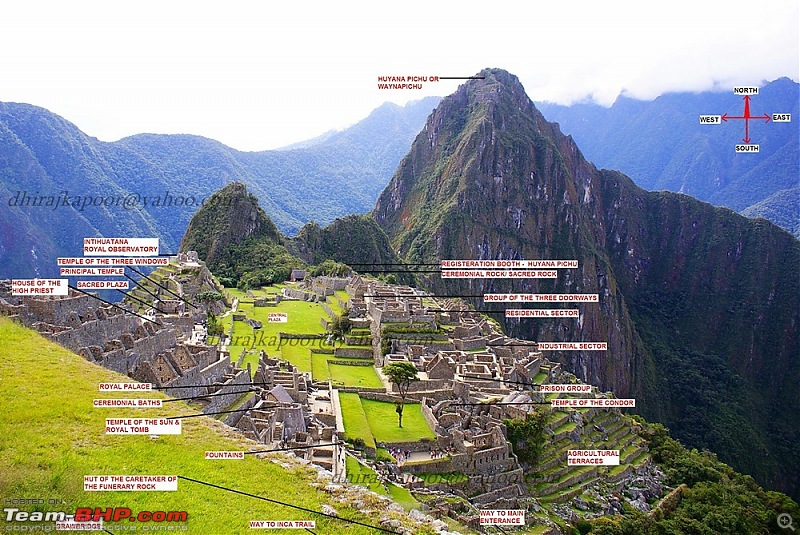 |
| |  (3)
Thanks (3)
Thanks
 |
| The following 3 BHPians Thank deky for this useful post: | BlackBeard, dailydriver, yosbert |
| | #75 |
| Senior - BHPian Join Date: Jul 2008 Location: Jaipur
Posts: 1,194
Thanked: 1,247 Times
| Re: To the Lost City of Incas - Peru on a Budget! 02/06/2013 - AGUAS CALIENTES TO MACHU PICCHU Today was the earliest that we had got up during our Peru Holiday. But today was going to be a child hood dream coming true. As mentioned earlier I had always wanted to see Machu Picchu since I had read about it in my history books. Reading about it in comics and seeing movies based on the Inca culture had made Machu Picchu that more magical, mystical and inviting to me. We had no problems in getting up at 0400hrs in the morning. Our host at the hotel was kind enough to be ready with breakfast at 0445 hrs. The plan was to reach the bus station to catch the early bus to Macchu Picchu, watch the sunrise, climb up the Huyana Picchu, visit the Machu Picchu ruins and then return back to Aguas Calientes by 1500 hrs to catch our train at 1700 hrs back to Ollantaytambo. We were not carrying much of luggage to Aguas Calientes and only 2 back packs, still we decided to keep one bag pack at the hotel and carry just one with water, some snacks, camera and all the permits with our passport to Machu Picchu. We were at the bus stop exactly at 0500hrs. We were thinking that we would be one of the first ones there, but to our surprise, there were many others, approximately 400 people ahead of us in the queue. Everyone was very excited and wanted to be up there as early as possible. Even the shops around the bus stop were open and the tourists were doing their last minute purchases of snacks and water. The shuttle buses had already started to fall in line and exactly at 0530hrs they started to seat passengers and left as soon as they were full. Since everyone was ready in a queue, filling up didn’t take much time and every 2 mnts or so a bus left. Ours was the 19th bus and soon we made our way up to Macchu Picchu. It was still dark outside and nothing much was visible. We could feel that we were ascending up the mountain via the numerous switchbacks. The buses that had left early had already started to come down to ferry more passengers up. The journey of around 8 kms from AC to the tickets and security of MP took us about 30 minutes. There was a huge queue again at the tickets and security counter at the Entrance of Machu Picchu, but the things seemed pretty organized. There were 5 counters and the staff was doing their job pretty efficiently. Anyways now I wasn’t in much of a hurry as the day was very cloudy and any hopes of watching the sunrise had been dashed. Our only objective now was to reach the Huyana Picchu registration booth before 0700hrs as were were booked in the earlier slot for the climb. After having our tickets checked against our passport and after passing the security we were finally inside the famed Machu Picchu. Though there was not much of sunlight and there because of the cloud cover we would miss the sunrise too, still the ruins looked beautifull and were supercharged and super excited to have reached there. We straight away made our way across the ruins of Machu Pichu and reached the other side for our climb to Huyana Picchu. Pics So far The long queue of tourists early in the morning all waiting to be transported to MP 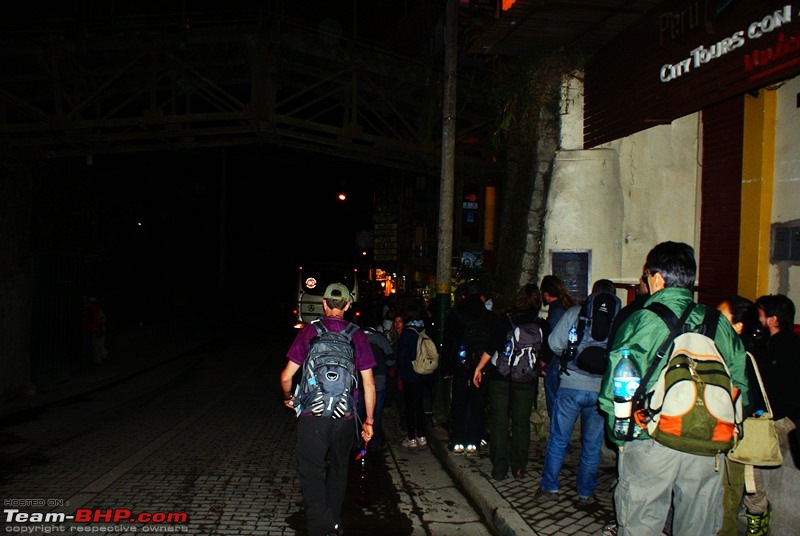 Waiting in excitement for our turn  Another wait at the entry point of Machu Picchu 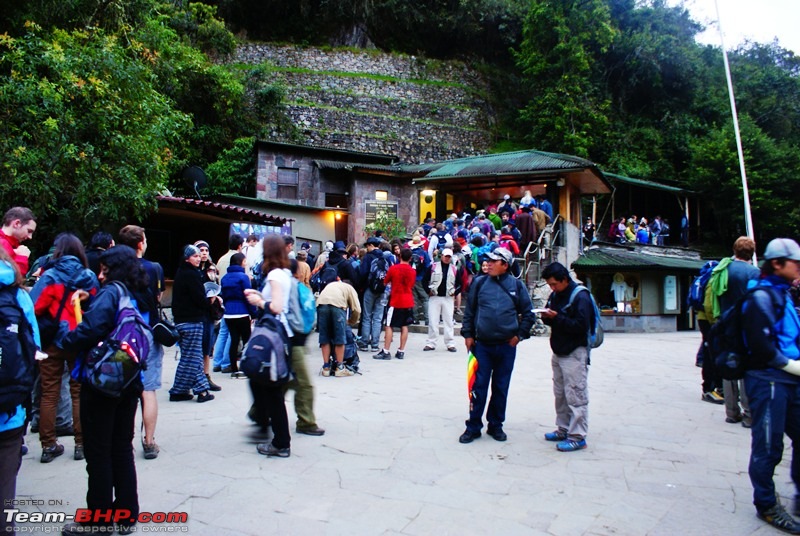 Came out of the queue for a photo 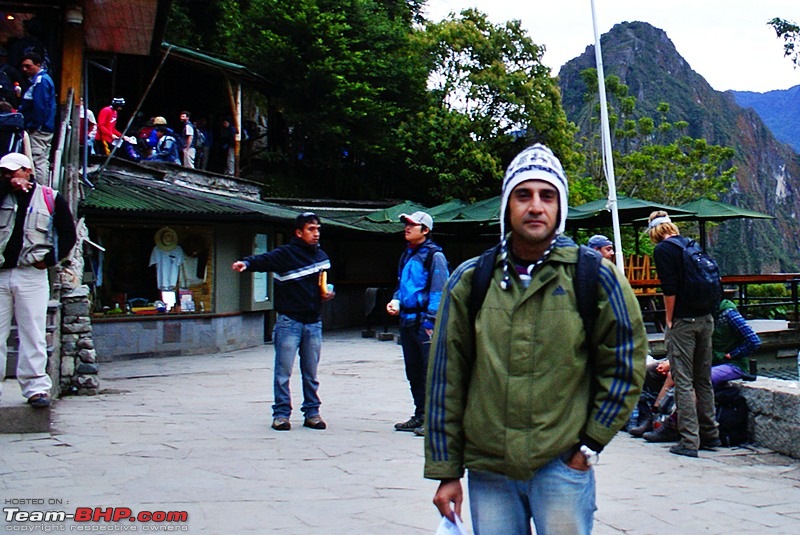 The base of the mountain is where Aguas Calientes is situated 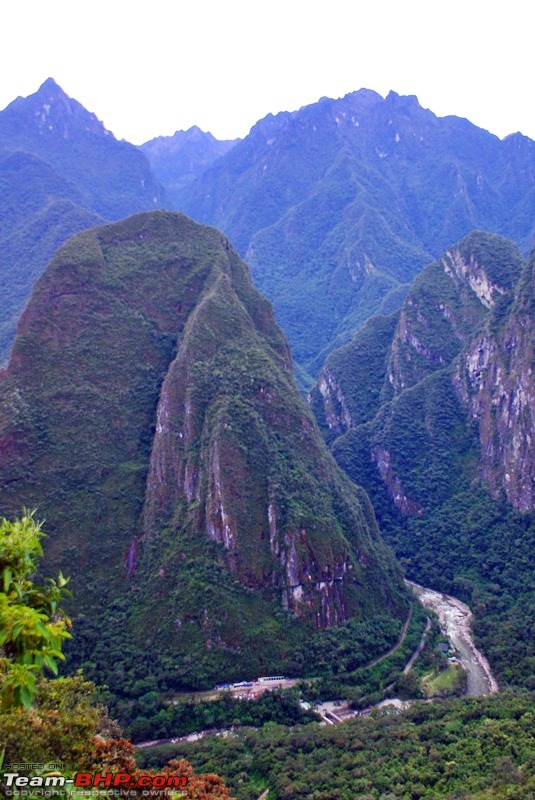 Finally inside Machu Pichu 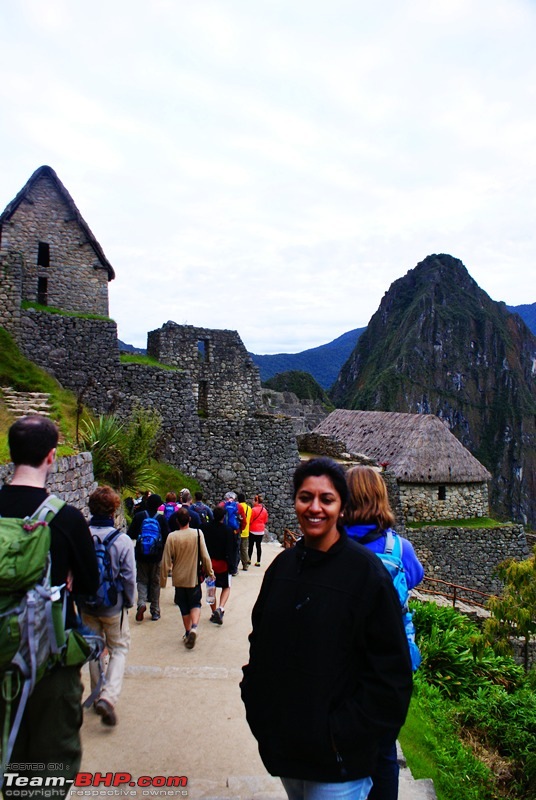 The ruins!! Lack of tourists early in the morning makes it that much special 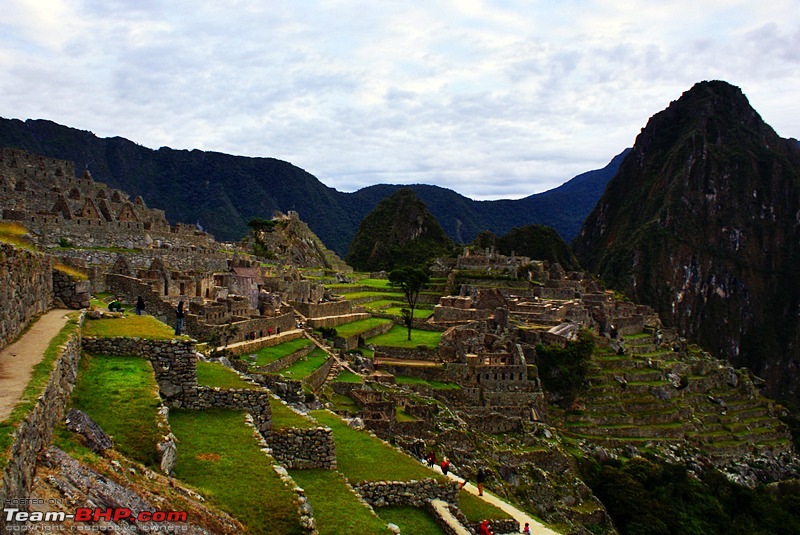 The permanent residents of Machu Picchu  The Llama mother and child 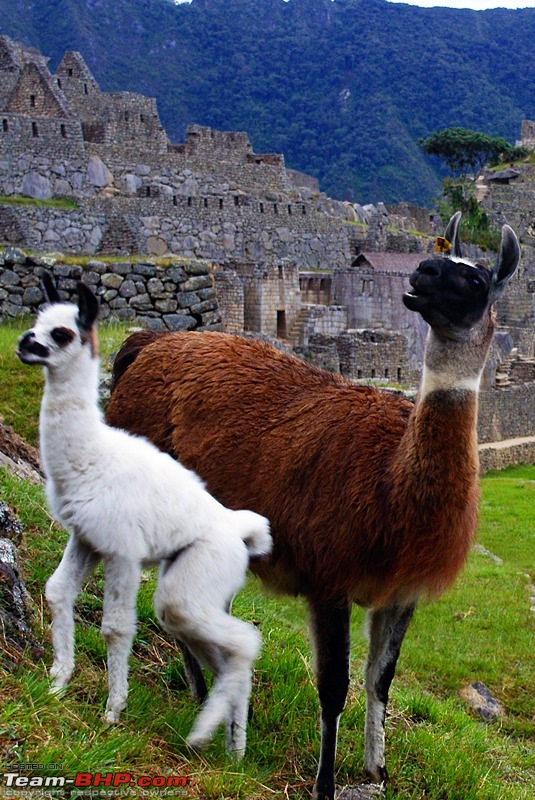 A happy wife, the ruins with Huyana Picchu in the back drop  Next post Huyana Picchu |
| |  (3)
Thanks (3)
Thanks
 |
| The following 3 BHPians Thank deky for this useful post: | BlackBeard, dailydriver, yosbert |
 |


